Catching bait is essential to catching many types of sought-after game fish in both saltwater and freshwater. Catching bait fish that predator fish are feeding on will greatly increase the chances of a productive day of fishing.
Having the correct cast net for the type of bait being targeted is very important. I have thrown cast nets over giant schools of bait and caught zero fish. In general, you want the largest diameter net you can throw with 1-1.5 pounds of lead sinkers per radius foot.
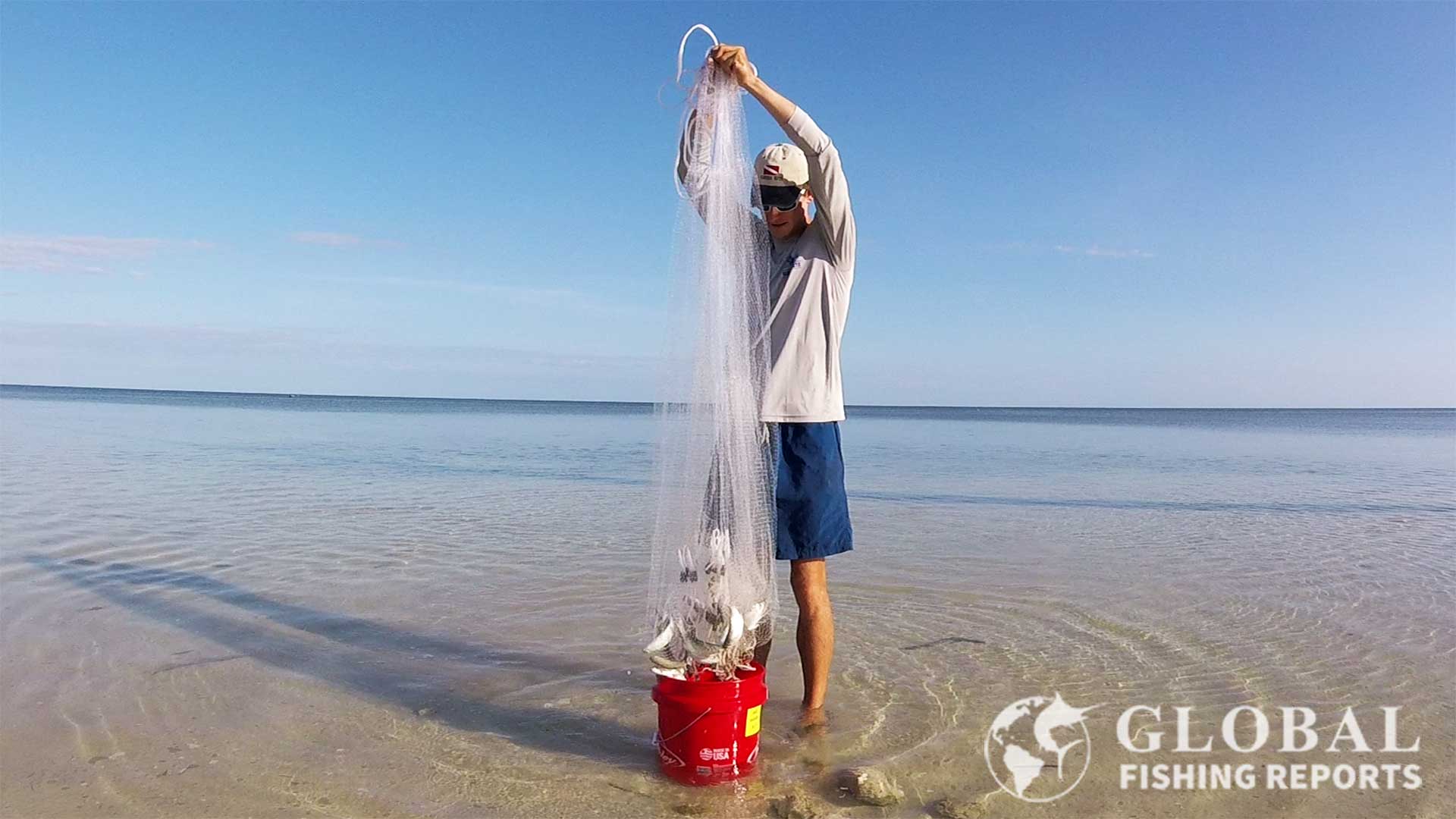
The mesh netting should be small enough to catch the targeted bait but large enough to sink quickly. Having a fast sinking net is most important when catching fish that are in deep clear water. Most nets work in shallow water because there is little time for the bait to escape.
Learning how to throw a cast net is the first step. I show two videos below on how to throw cast nets. Practice throwing in the grass or in the water where the area can be disturbed is a great idea. You don’t want to be next to a school of bait you need to catch and be wondering if the net is going to open.
Selecting the Right Cast Net
Betts Morada Cast Net, 8-12 Foot
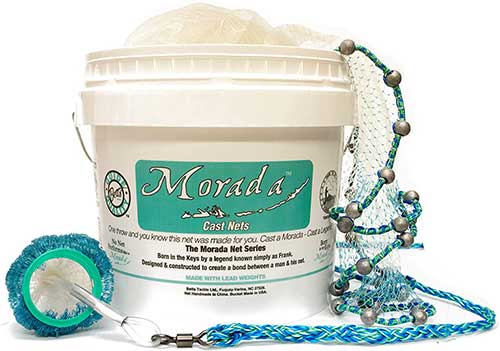
Shop Bass Pro Shops
Estimated Price: $170-$260
Betts has introduced a new 1.3 pound series to their top quality Morada cast net line. This net was designed in the Florida Keys to catch all types of baits from small pilchards to adult mullet. The mesh size can be selected from as small as 1/4 inch to catch small bait and offers up to 1 inch mesh to catch larger baits in deep water.
Round lead weights are the best type when throwing a cast net. They get snagged less in the net allow it to open evenly and smooth. The 1.3 pound option allows for a lighter overall net when throwing in shallow water. Having 1.6 pounds of lead per radius foot is a heavy net which is good when throwing in deep water to catch cigar minnow, goggle eyes, mullet, mackerel, and bunker. The lighter 1.3 series net is still plenty heavy to catch pilchards, pinfish, ballyhoo, mullet, greenbacks, and sardines. If you are looking for a cheap net, there are better options but this is a great cast net for professional fisherman.
In the video above I show the best way to throw a cast net. It’s a good method that allows you to stay completely clean!
Betts Old Salt Cast Net, 4-8 Foot with 3/8 Mesh

Buy from Amazon
Shop Bass Pro Shops
Estimated Price: $43-$120
This is a great net for most users! This net comes in sizes of 4 foot, 5 foot, 6 foot, and 8 foot. The net has 1-pound of lead weights per radius foot. The 3/8 inch monofilament mesh is good for catching most types of bait.
If you are a beginner or on a budget the Betts Old Salt cast nets are great all-around nets! These cast nets are what I would call the standard or average quality cast nets. With 1 pound of weight per radius foot, the net sinks reasonably fast and is manageable to throw for long periods of time if needed. If this is the first cast net for a user, selecting a net that has a radius that is 1 foot shorter than the thrower is a good idea. This allows for the easiest and most basic throwing technique to be used. Once the user gets proficient they can throw a larger size cast net with more advanced throwing techniques.

In the picture, I am throwing a 6-foot cast net to catch mullet in shallow water in the Florida Keys.
Betts Old Salt 8-Foot with 3/8 Mesh
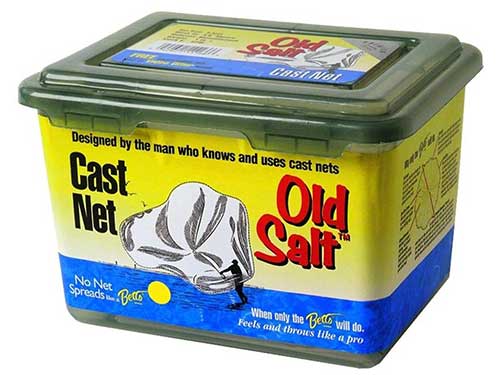
Buy from Amazon
Shop Bass Pro Shops
Estimated Price: $80-$120
Bettes Old-Salt cast nets are also available in 10-foot and 12-foot. The PM series has a 3/8 inch mesh and the SM series has a 1/2 inch mesh size. This cast net has 1 pound of lead weight per radius foot.
I used the 12-foot version of this net in the video on this page showing how to throw a large cast net. This cast net is of average quality. It is not a high-end 6-panel net but is about half the price. The mesh is lightweight soft, easy to throw, and allows the net to sinks fast. However, the net is not reinforced at the top and bottom and is not made with heavy premium mesh material. For these reasons, it will likely not last as long top quality nets.
These large net will work great for catching pilchards, goggle eyes, scaled sardines, and ballyhoo. The 3/8 inch mesh allows for bait to be caught in shallow and medium-depth water. Although it is not top-of-the-line this is still a good cast net that will work for most recreational fishermen.
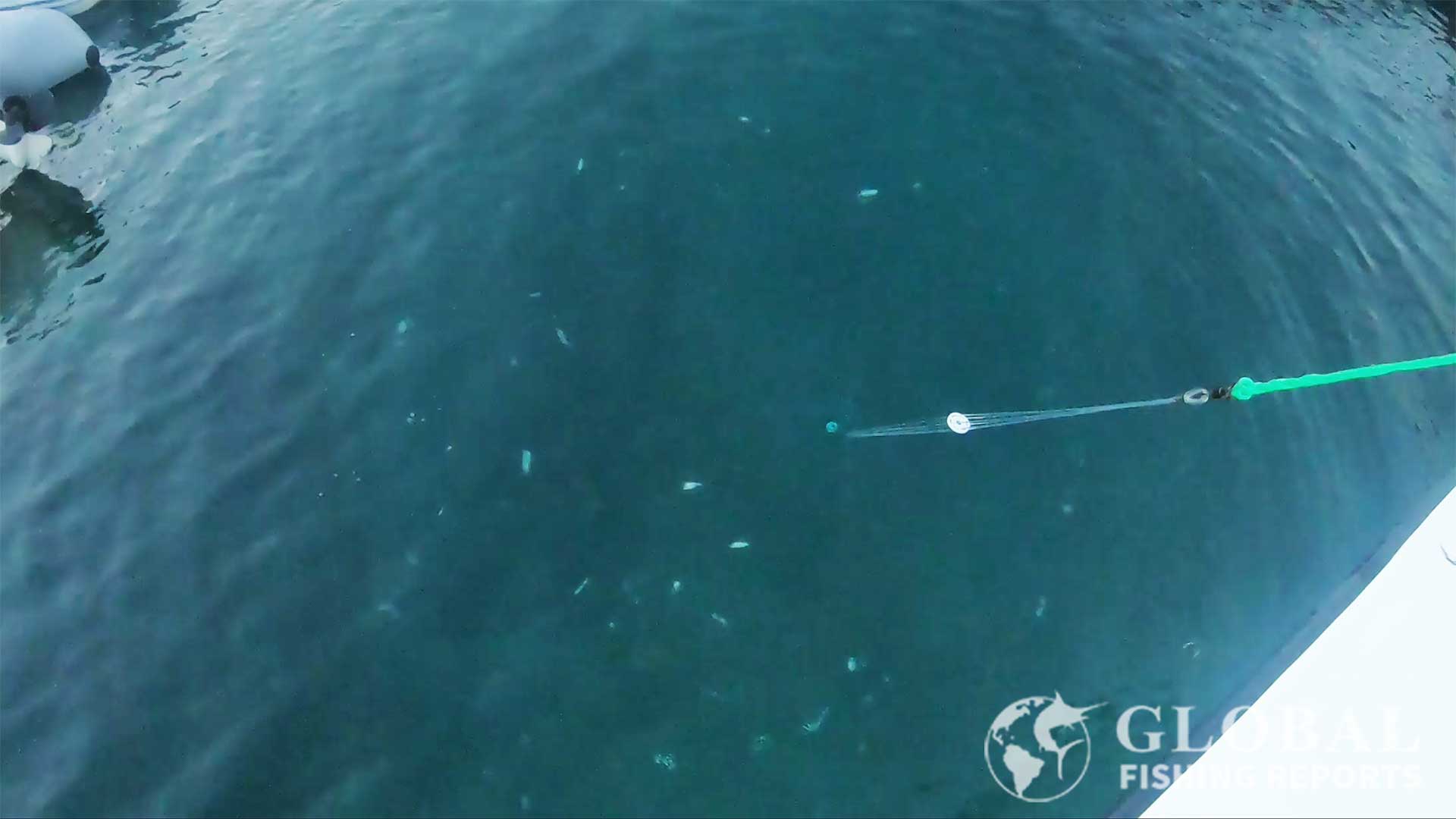
In the picture above I am catching pilchards with a 12-foot cast net in the USVI.
Calusa 10-Foot Net with 3/8 Mesh
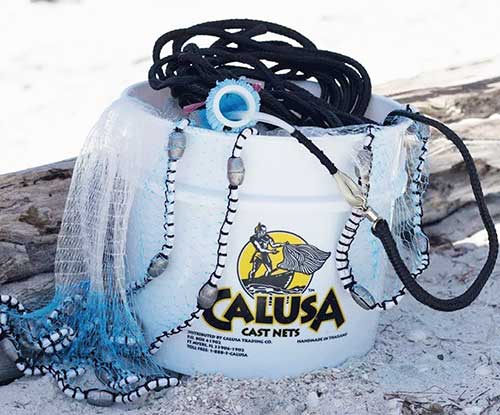
Buy from Amazon
Estimated Price: $270
Calusa cast net comes in sizes of 8 foot, 10 foot, and 12 foot. Mesh size options are 3/8 or 1/2 inch square mesh. It is weighted with 1.5 pounds of lead weights per radius foot. The top of the net has a 1-1/4 inch horn opening which enables the net to lay flat. This net is built with 120-pound monofilament bail lines.
These Calusa cast nets are known to be one of the most quality cast nets that are commercially available. The nets are hand-tied from 6-panel sections in Thailand. This is how custom nets are made and allows them to lay much flatter when thrown. This net also uses a stronger monofilament mesh net the top and bottom of the net where it is more likely to tear.
This high-end cast net is heavy, quality, and expensive. This is the best net for someone with experience throwing a net that needs to catch lots of bait. If I could only have one cast net this would be it but it not necessarily the best net for beginners. You should learn how to throw and retrieve lightweight low-cost cast nets first.
That being said with my video above on how to throw a cast net, you could learn pretty quickly how to throw any size cast net and catch bait. Just be careful not to get the net snagged on the bottom. Throw the net over grass, mud, sandy bottoms, or in deep water.
Custom Hand-Tied Cast Nets
These nets are very similar to custom hand-tied nets that can only be purchased locally in the USA. Purchasing local custom made nets is a great way to get and net. Expert net makers can make custom nets to match the exact user’s needs. However, if you need a net quickly and do not want to wait or do not know of a local net maker this is a great way to go. There is another net made by the same company called a Cracker cast net that is lower cost but is not built with the top-notch quality of a Calusa cast net.
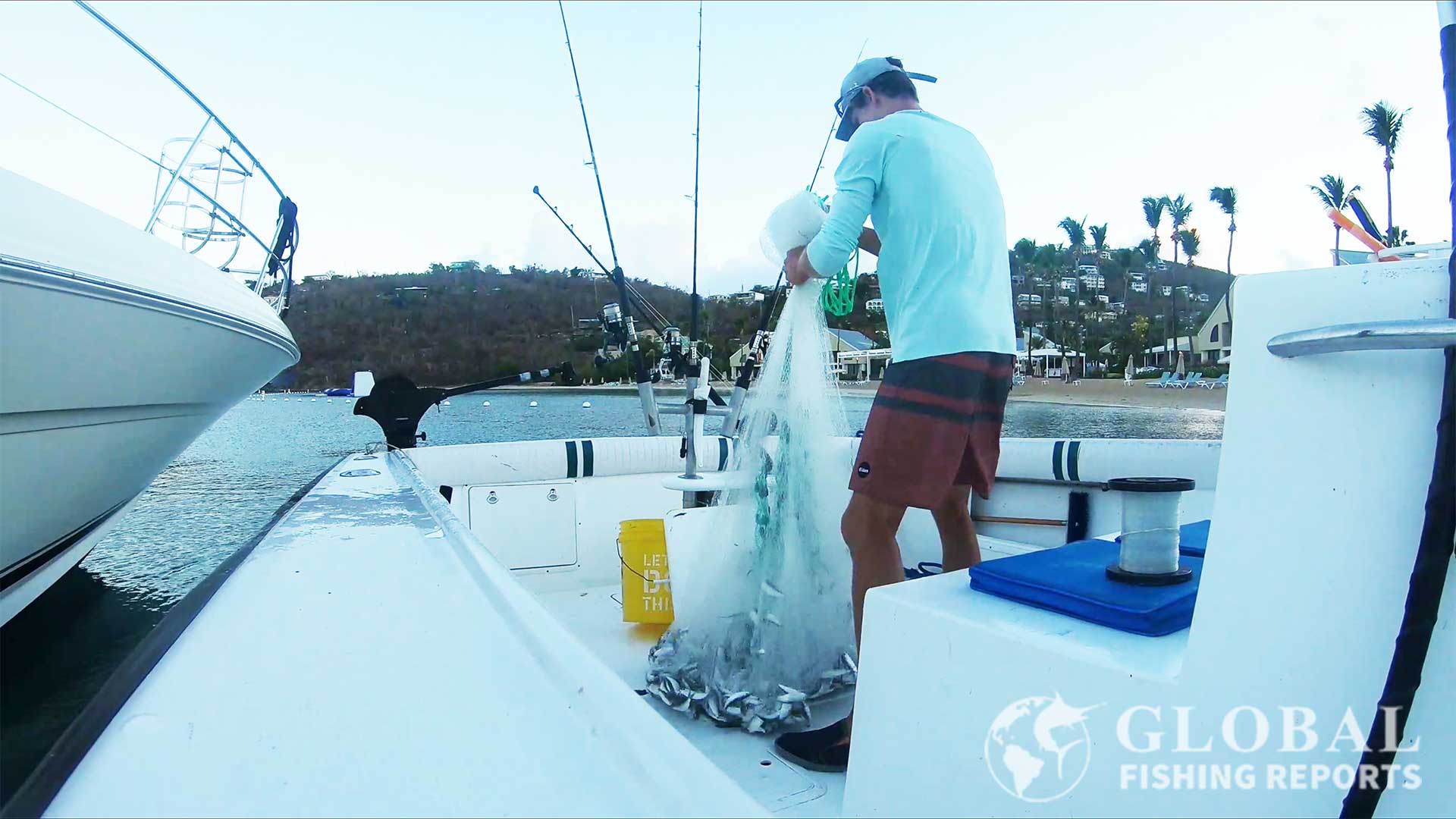
In the picture below putting pilchards in a live well that were caught with a 12-foot cast net in the USVI.
Bait Buster 5-12 Foot Net with 3/8 Mesh
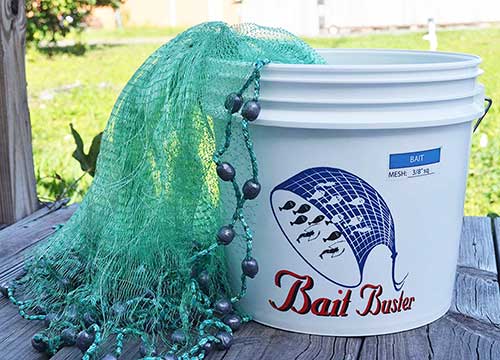
Buy from Amazon
Estimated Price: $170-$230
The Bait Buster professional-grade cast net has 3/8 square mesh. This net comes in sizes of 5 foot, 6 foot, 7 foot, 8 foot, 9 foot, 10 foot, and 12 foot in radius. This cast net has 1.5 pounds of lead weight per radius foot. A 25-foot poly braided hand line is used with 100-pound monofilament braille lines.
These nets come with a 3.5-gallon bucket for net storage. The 3/8 inch mesh is good for catching bait 2 inches and up in shallow to medium depth waters. This is a great cast net for catching most types of bait! A 10-foot bait buster cast net with 3/8 inch mesh is a versatile cast net to have on the boat and can catch most types of bait.
The Bait Buster cast nests also come in 1/2 and 5/8 inch mesh sizes. These mesh sizes are good for bait larger than three inches, such as goggle-eye, finger mullet, and small bunker. These mesh sizes will allow the net to sink faster which will work better in deeper water. In general, though the 3/8 inch mesh works well to catch most types of bait, mesh larger than 1 inch is really only needed to catch really large bait like large mullet or bunker.
Ahi USA 200 Series Cast Net 3-6 Foot with 3/8 Mesh
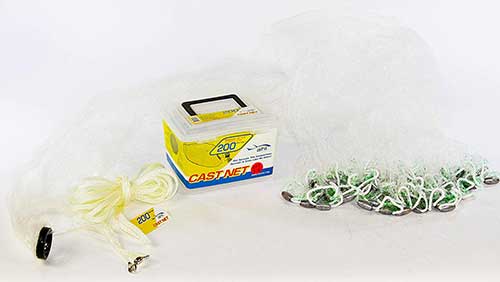
Buy from Amazon
Shop Bass Pro Shops
Estimated Price: $49-$180
The Ahi 200 cast net comes in sizes of 3 foot, 3.5 foot, 4 foot, 4.5 foot, 5 foot, 6 foot, and 7 foot in radius. It has 3/4 pound of lead per radius foot. It is a 6 panel net with a double selvage stitch pattern for 2 times the strength at critical points. The braille lines are 80 pounds and the mesh netting is made with premium monofilament. A 24-foot hand line is connected to a large anodized swivel.
This is the best net for most cast net users. I love having a small 6-foot cast net to catch bait from the shore. The 3/4 pound of lead per radius foot makes it a light net that is easy and fun to throw. Typically, 1-pound of lead per radius foot is desired to allow the net to sink fast. However, this net actually sinks fast and is great for catching bait in shallow water.
Watch the video below where I am using this net to catch mullet. I catch the mullet in shallow water and near the surface in deep water. Often times it is more about cast placement than the size of the net. I can throw this net so far I could often use a longer hand line.
Ahi USA 600 Pro Series 1/4 Inch Mesh, 5-12 Foot
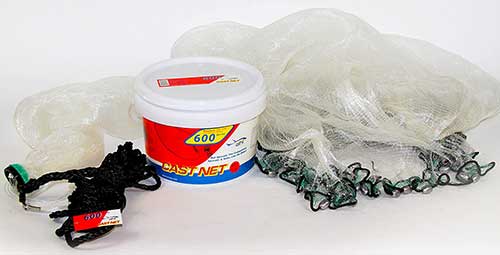
Buy from Amazon
Shop Bass Pro Shops
Estimated Price: $82-$176
This Ahi Pro cast net has 1/4 inch mesh Size options include 5 foot, 6 foot, 7 foot, 8 foot, 10 foot, and 12 foot. It has 1.35 pounds of lead weight per radius foot. Netting material is made with premium clear monofilament mesh netting. Double selvage stitch patterns allow for 2 times the strength at critical points near the top and bottom of the net. Braille lines are made with a 100-pound monofilament. Also included is a bucket that works to store the net.
The small mesh size works well for targeting minnows and shrimp that are 1.5 inches and up. A 3/16 inch mesh is the smallest mesh size they make for cast nets. Small mesh sizes make cast nets sink slower. With the heavy lead weights, this net can catch bait in shallow to medium depth waters.
This net is built with panel sections that allow the net to lay flat and open wide. Getting a quality net with a fast sink rate is important when casting into a school of small minnows in open water. If this is what the big fish are actively feeding then why not catch it and use it for bait!
In the picture above,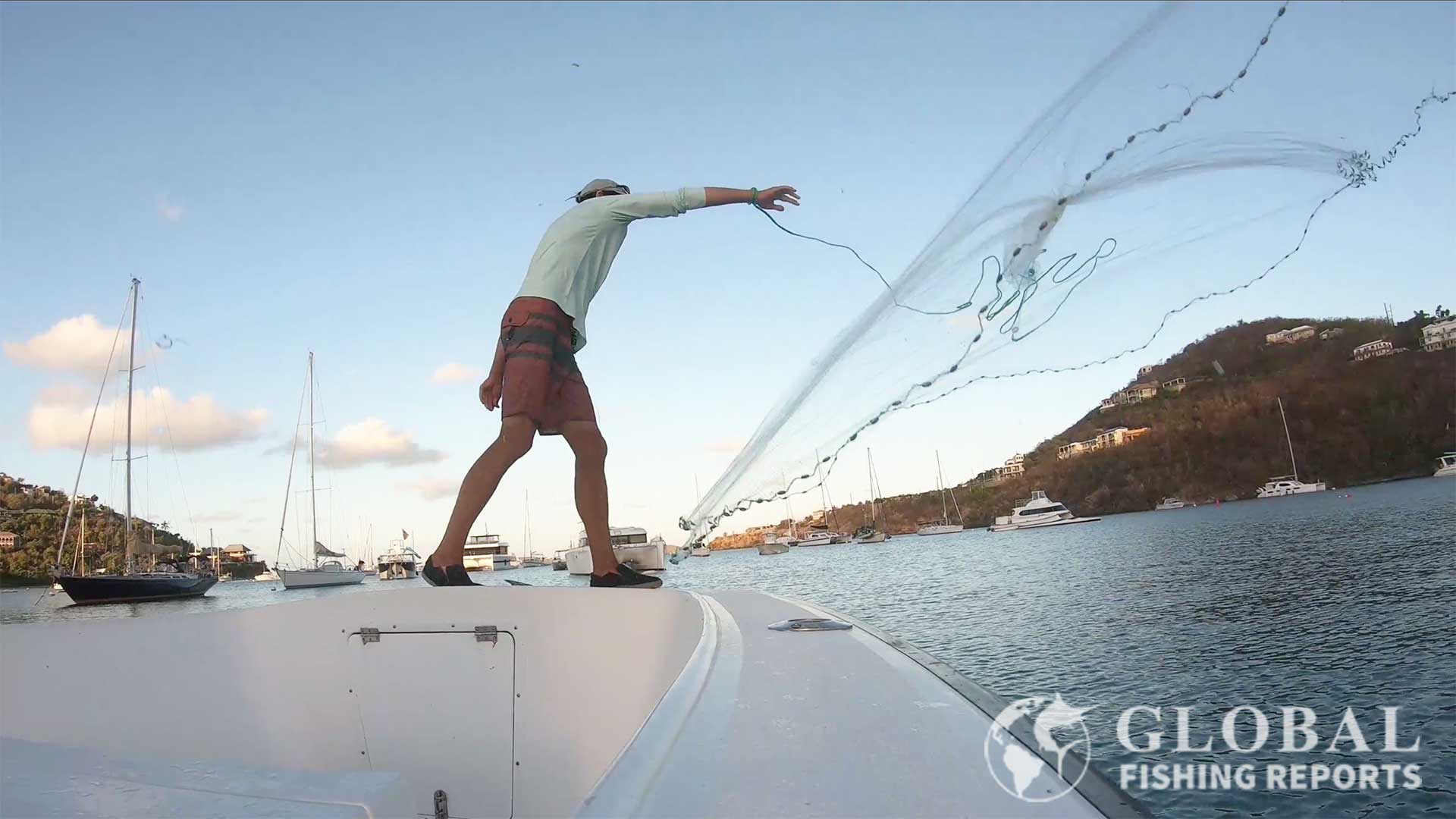 I am throwing a 12-foot cast net in the USVI.
I am throwing a 12-foot cast net in the USVI.
Mullet Buster Cast Net 6-12 Foot with 1-1/4 Mesh

Buy from Amazon
Estimated Price: $140-$250
Bait Buster Professional Grade Cast Nets have 1-1/4 square mesh. This net comes in 6 foot, 7 foot, 8 foot, 9 foot, 10 foot, and 12-foot radius sizes. This cast net has 1.5 pounds of crimped bar lead weights per radius foot. It is built with 100-pound monofilament braille lines and has a 25-foot poly braided hand line. A 3.5-gallon bucket comes with the net for easy storage. Betts Mullet cast net listed by Bass Pro Shops is similar with 1.3 pound of lead per radius foot and 1 inch mesh.
Large schools of mullet often appear as dark areas in sandy or grassy bottoms or can be breaking the top of the water. Having a fast sinking net is the best way to catch mullets that are deep in clear water. The 1-1/4 inch mesh size with 1.5 pounds of lead per foot is good at catch bait 8 inches and up in deep water.
Manhaden also called bunker are another type of large baitfish that are difficult to catch with a small slow sinking cast net. I bet it is possible to catch large bunker with a small net. However, a large fast sinking cast net is best for catching this type of bait in deep water. I prefer round weights to bar-style weights but depending on the lead line stiffness round weights do not always work well with 1 1/4 mesh. I do not know of a commercially available net with this mesh size over 1 inch that uses round weights.
How to Catch Bunker for Bait with a Cast Net
The video above shows how to catch bunker. Even though you have a large fast sinking net does not mean that catching the bait is guaranteed. When catching bunker we back over them with the boat to send them deep where the fast swimming fish will not be spooked by the splash of the net. Then in the murky waters of New Jersey, the bait can be caught in large numbers.
The cast net I used in this video to catch bunker was a locally made custom Percy cast net that I picked up from Mr. Percy who was very helpful and showed me a method to throw the large net. The net was made from 1 1/4 inch square mesh which is 2 1/2 inch in length when stretched. The net had 1 1/4 pounds of lead per radius foot made from hand-tied evenly space 1-ounce ball sinkers. This is good for baits larger than 7 inches. Really this is a net specifically used for bunker or deep mullet. He makes nets with 1/2 inch square mesh for smaller peanut bunker.
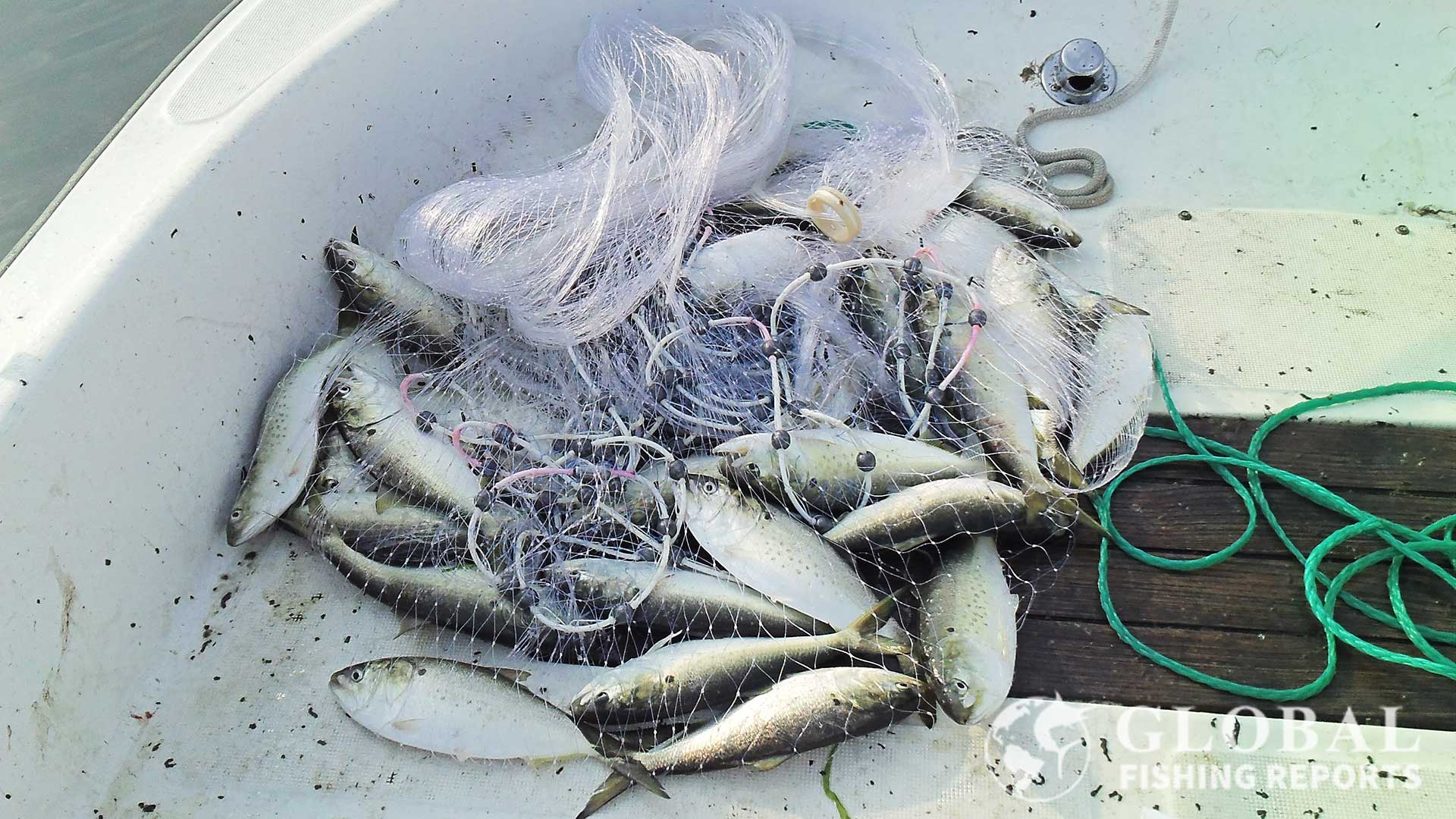
In the picture above I caught menhaden also called bunker with a 10-foot cast net in New Jersey. These baitfish are about 12 inches in length.
Offshore Angler Heavy Cast Net
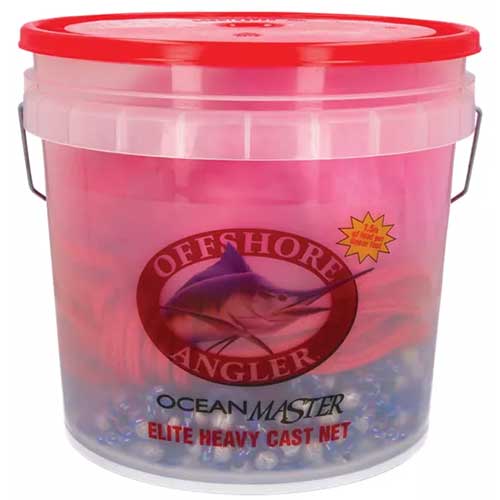
Shop Bass Pro Shops
Estimated Price: $220-$230
Bass Pros Shops makes the Offshore Angler Ocean Master cast net. This is a hand tied net with heavy 1.5 pounds of round lead per radius foot. I really like round weights which allow the net to open smoothing, have minimal splash, and sink quickly.
Something unique about this net is that it has pink mesh. This could be advantageous in clear deep water as it may appear less visible to the bait fish. The cast net come in 10 foot and 12 foot radius sizes. Mesh size options are 3/16, 3/8, and 1/2 inch. It it difficult to find a large 10 foot plus size net with 3/16 inch mesh so this is a great option when trying to catch fry fish, silver sides, minnows, small pilchards, and most notably shrimp! It is a good idea to use 3/16 or 1/4 inch mesh when trying to catch shrimp in a cast net. 3/16 inch mesh is the smallest size mesh for any cast net.
Wide Open Cast Nets 5-12 Foot
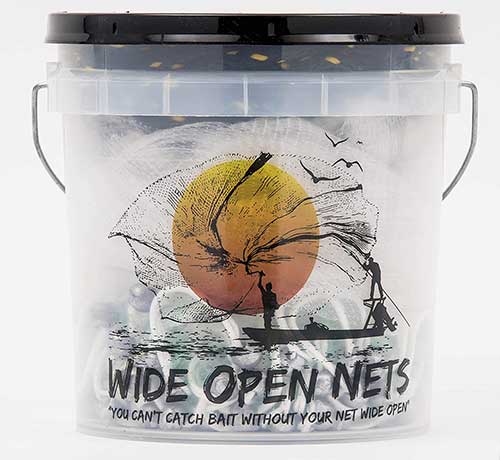
Buy from Amazon
Estimated Price: $150
Wide Open Nets are becoming more popular. These are above-average quality nets and come in many sizes from 5 foot to 12-foot radius. Mesh sizes available are 3/16, 1/4, 3/8, and 1/2 inch square mesh. The company Wide Open Nets is based in Stuart Flordia but the nets are made in China.
Features of the net include a 6-panel hand-tied design, large horn, and 27-foot hand line. Round lead weights are used to allow the net to sink quickly. The nets come in 1-pound or 1.5 pounds of weight per radius foot. For shallow water, 1-pound is a good option. In deep water when targeting fast swimming fish, the 1.5 pound allows the net to sink faster. It does take more effort to throw a heavy net so take that into consideration when selecting the net weight. The lead is tied on each end to secure the weights to the lead line.
Lead-Free Cast Nets
Lead-free cast nets are not as heavy per radius foot as lead cast nets. However, if I am catching bait in shallow water where the heavy weight is not needed I prefer to use the lead-free nets. After all lead can be toxic and having less lead on the floor of the boat seems like a win.
These nets typically use steel weights with vinyl or plastic covers that not only eliminate the environmental concerns of lead but also help prevent scratches on boat decks. They’re particularly good options for families with children and for fishing in environmentally sensitive areas. The slight reduction in sink rate is rarely an issue in shallow water situations.
Lead Free Cast Net: Goture
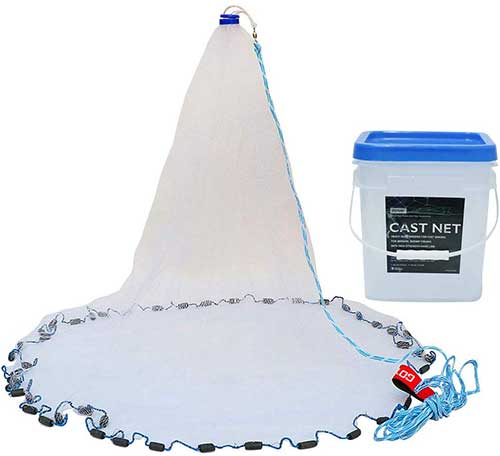
Buy from Amazon
Estimated Price: $43-$114
Goture American Saltwater cast nets come in sizes of 4 foot, 6 foot, 8 foot, 10 foot, and 12 foot. A 3/8 inch monofilament mesh size is used. It had 3/4 pounds of iron weight per radius foot. The weights have plastic covers and are lead-free. A neoprene wristband is attached to the end of the 32-foot floating hand line. This is a great net for beginners and for users catching bait in shallow water. It is good at catching bait in water less than 3 feet deep.
Being light it is easy to throw and the plastic covers on the weights help to not scratch the bottom of the boat. The targeted bait size with a 3/8 inch mesh is 3-6 inches. This same net is available with 1/4 inch mesh to catch smaller bait. It also comes with a bucket large enough to store the cast net. This net will not last as long as a high-end 6-panel net but it is easy to throw and will catch bait in shallow water.
Lead Free Cast Net: Betts Buddy Cast 3-5 foot with 3/8 Mesh
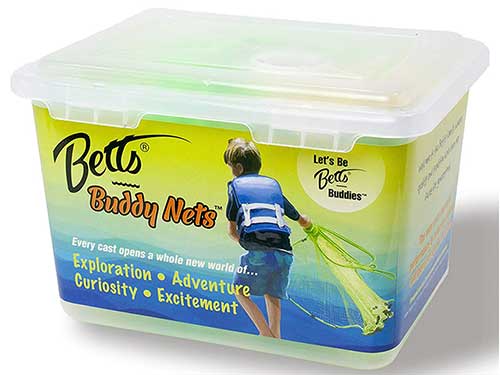
Buy from Amazon
Shop Bass Pro Shops
Estimated Price: $26-$56
Betts Buddy cast nets come in sizes of 3 foot, 4 foot, and 5 foot. The Mesh size for the nets is 3/8 inch. Coated iron weights are used to weigh the net at 3/4 pound per radius foot. A bright chartreuse monofilament line is used for the netting material. This allows parents to keep an eye on their kids that are using the net. It might not be the best color net to have but it still catches plenty of fish.
I really like that this is a lead-free cast net for kids. Heavy lead weights are not needed to catch bait in shallow water. Kids probably have more fun throwing a cast net on a fishing trip than they do fishing. There is constant action and you never know what you are going to catch.
The only problem kids have is learning to throw a cast net. Check out my page on How to Throw a Cast Net for more information.
Lead Free Cast Net: Ahi USA 50 Series Monofilament Cast Net 3-7 Foot
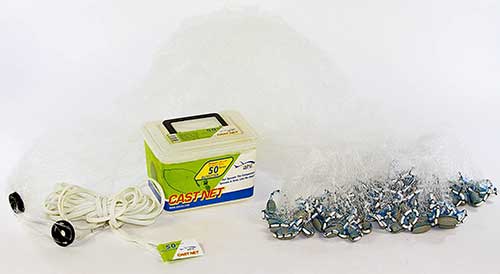
Buy from Amazon
Estimated Price: $42
Ahi USA 50 series cast nets come in sizes of 3 foot, 4 foot, 5 foot, 6 foot, and 7 foot. Steel weights with vinyl covers are used to weigh the net at 3/4 pound per radius foot. Premium clear monofilament netting is used with 80-pound braille lines.
This is a good net to use in shallow water. It is similar to the Ahi 200 series except this net uses steel weights. For the price, this is a good net is a good value. I would recommend this net for kids because it is a lead-free option, has clear mesh, and is quite durable.
Lead-Free Cast Net: South Bend Lead-Free Cast Net 4-Foot with 3/8 Mesh
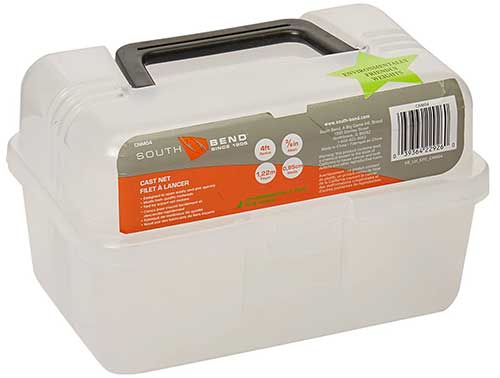
Buy from Amazon
Estimated Price: $27
This South Bend Cast net comes in sizes of 3-foot or 4-foot. The mesh is made with clear monofilament and has 3/8 inch square mesh. Steel weights are used and have plastic covers.
This is a low-cost net that is good for kids or adults who are catching bait in shallow water. A 4-foot cast net is pretty small but can still catch lots of cool fish. A three-footer is the smallest cast net they make and is more difficult to catch bait with. I like cast nets that are lead-free for kids to use.
South Bend Cast Net 7-foot with 3/8 Mesh
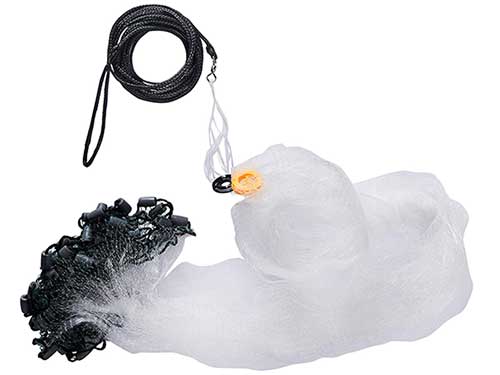
Buy from Amazon
Lightweight Cast Nets with Steel Weights
Estimated Price: $34-$90
This South Bend cast net has a 7-foot radius. It has clear monofilament netting with 3/8 mesh. It is manufactured in China. This is the same cast net reviewed above but has a large radius.
These cast nets are just about the lowest-cost nets on the market. They are not high-end but do work to catch bait. The steel weights are considered environmentally friendly.
In some ways having a light net is an advantage. Throwing cast nets all day causes fatigue and it is just a hassle using heavy cast nets. When throwing nets in water less than three feet deep lots of baitfish will be caught even using small lightweight nets. A 7-foot net is a good-sized net for catching bait from shore. It can be thrown far away and is still large enough to catch lots of fish with each cast.
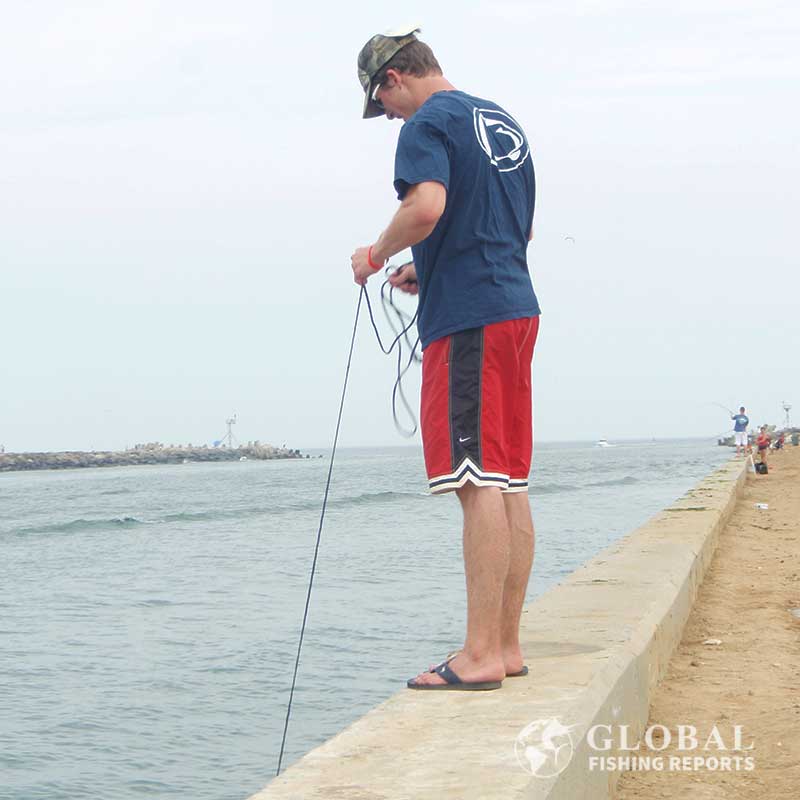
Lead-Free Cast Net: Winged Chain Bottom Cast Net 5-12 Foot with 3/8, 1/2, and 1 Inch Mesh
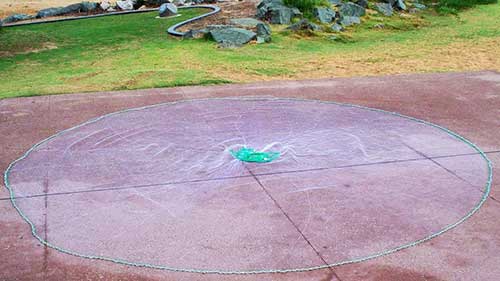
Buy from Amazon
Estimated Price: $60-$160
The winged fish cast net comes in sizes of 5 foot, 6 foot, 7 foot, 8 foot, 9 foot, 10 foot, and 12 foot. Mesh size options are 3/8, 1/2, or 1 inch. This is a quality elite series 6-panel cast net. It is unique because it is weighted at 1 pound per radius foot with a steel chain around the perimeter of the net. This style of net is called a chain bottom cast net. It also comes with a 30-foot hand line.
Chain bottom nets are said to open more easily and uniformly than other cast nets. They also claim to reduce tangles and close better on the bottom. I personally have not used a chain bottom net so I can not say whether these claims are accurate. This does seem like a quality net that would catch bait. My only concern would be whether the chain dragging on the floor of the boat would cause any issues. When loading cast nets with lead weights it is already quite loud and noisy. It is possible that is chain bottom net would actually be better. I also wonder if the chain noise would spook the fish or not. My guess is that these are not problems and that the net would work well.
Lead-Free Cast Net: Ez Throw Cast Next 4-Foot with 3/8 Inch Mesh
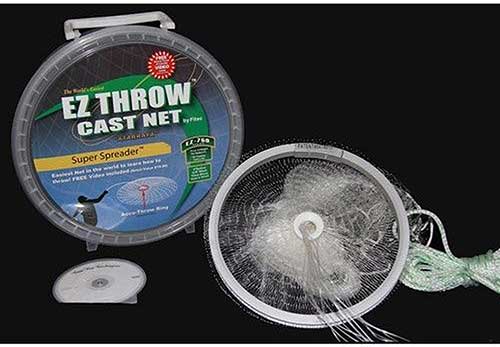
Buy from Amazon
Shop Bass Pro Shops
FITEC EZ Throw Super Spreader cast net with an aluminum ring. This net has a 4-foot radius and has 3/4 pounds of weights per radius foot. The hand line is 20 feet long and is made from a polyethylene material which allows the line to float. This net works to catch bait 2 inches and up in shallow water. It comes with an instructional DVD on how to throw the net.
The easy throw cast nets with aluminum rings demonstrate the easiest way to throw a small cast net. I would not recommend buying this unless you are really struggling to throw a cast net. The ring is unnecessary and it makes it a pain to store the net. The method used to throw the net is the best way for a beginner to throw and works if the net is about 1 foot shorter than the user.
Easy Way to Throw a Cast Net
The basic method to throw a cast net starts by having the net by your right side if you are right-handed. Hold it at the horn(top of the net) with your dominant hand and pick up the lead line in one spot with the other hand. Place the lead line over the top of the horn and your dominant hand. Grab the lead line about 2 feet down the lead line with your non-dominant hand and you are ready to throw. When throwing swing the net out with your dominant hand and pull back the lead line in your non-dominant hand. The net should open right up.
With the EZ throw ring when the lead line is brought to the top of the net it is wrapped around the ring rather than the horn. This is largely unnecessary but may help with the initial concept if you have never thrown a cast net. This general approach is how I have thrown nets under 5 foot and I am over 6 feet tall. With a 6-foot net, it drags on the ground while swinging during a cast and gets caught on everything. This can be overcome by starting 1 foot down the net if the 13-inch metal ring is not on the net.
Understanding Cast Net Mesh Sizes
The mesh size of your cast net is crucial for targeting specific bait types. In almost all cases, the mesh size is given in terms of square mesh, not stretched mesh. Stretched mesh is the diagonal length between knots and is about double the square mesh value. For example, 1/4 inch square mesh is 1/2 inch when stretched and 1-inch square mesh is 2 inches when stretched.
Small Mesh Nets (3/16 inch and 1/4 inch)
These nets are primarily used to catch minnows and shrimp between 1 and 3 inches. Sometimes these are called fry cast nets.
Medium Mesh Nets (3/8 inch)
This is the most versatile net size because it can catch small 3-inch baits and still sinks fast enough to frequently catch large baits like mullet and goggle eyes. Common baits caught with 3/8 inch mesh include shrimp, pilchards, scaled sardines, threadfin herring, pinfish, speedos, finger mullet, shad, and ballyhoo.
Large Mesh Nets (1/2 and 5/8 inch)
These mesh sizes work well to catch bait between 4 inches and 10 inches. Common baits caught include finger mullet, goggle eyes, and cigar minnows.
Extra Large Mesh Nets (1 and 1-1/4 inches)
These nets are used to catch mullet and bunker over 10 inches. These large baits can often evade a slow sinking net. However, in shallow water, large baits can be caught with a smaller mesh size.
Cast Net Diameter and Weight
Small Cast Nets (3-5 foot radius)
These nets are ideal for beginners and kids. They’re easier to throw and manage, though they cover less area. They work well in shallow water and for smaller bait fish. With a small net, you may need more throws to catch the same amount of bait as a larger net.
Medium Cast Nets (6-8 foot radius)
These versatile nets balance ease of use with coverage area. Most recreational anglers find these nets sufficient for their bait-catching needs. They’re manageable to throw for extended periods and can be used from shore or smaller boats.
Large Cast Nets (10-12 foot radius)
These nets are for experienced users who need to catch large quantities of bait or target bait in deeper water. They require more skill to throw properly but cover much more area with each cast. Professional fishing guides and charter captains often prefer these larger nets.
Weight Considerations
The weight of lead or steel per radius foot affects how quickly your net sinks:
- 3/4 pound per radius foot: Lightweight, easier to throw but sinks slower
- 1 pound per radius foot: Standard weight, good balance of sink rate and ease of use
- 1.5 pounds per radius foot: Heavy, sinks quickly but requires more strength to throw
For shallow water (less than 3 feet), a lightweight net often works fine. For deeper water or fast-swimming bait, a heavier net that sinks quickly is necessary.
Cast Net Size Guide
For Beginners
It’s best to get a cast net under 8 feet in radius. This is because it’s easier to learn how to properly handle a cast net without dealing with a huge one. The most difficult thing to learn is how to properly untangle the cast net. Every step of the cast net process is easier with a smaller cast net, though more throws are often needed to catch the same amount of bait.
For Kids
The best size cast net for kids is between 3 feet and 6 feet depending on the size and experience level of the child. In most cases, a 4-foot cast net is best for kids. It’s easy to throw and it’s amazing how much fish it can still catch.
For Experienced Anglers
If I could only have one net, I would probably get a 10-foot net with 3/8 mesh. This is a versatile net that can catch almost any kind of bait such as pilchards, ballyhoo, bunker, shad, pinfish, and mullet. I also really like having a small 6-foot net with a 3/8-inch mesh that I can cast far from shore in the shallows.
That said, it also really depends on what type of bait I need to catch for the day. When catching large bunker in New Jersey, it’s important to use a cast net that is 10 feet or bigger with a large mesh around 1 inch so that the net sinks fast enough to catch the bait. In clear deep water, it’s also important to throw a large net with large mesh to catch baitfish like mullet.
Cast Net Throwing Techniques
Check out the How To Throw a Cast Net page, for detailed instructions on how to throw a cast net. There are three common ways to throw a cast net.
Triple Load Method
For large cast nets, the most common method is the triple load method. This method works well but the net is placed on the shoulder. After throwing the net the first time the net is wet and the user gets messy after the first throw.
Easy Throw Method
The second common way to throw a cast net is called the easy throw method. This works well for cast nets under 5 feet in radius. This method is quick and easy but does now work for large cast nets.
In the video above I show how to throw a castnet with the easy throw method.
Clean Throw Method
This method doesn’t have an official name but is the best way to throw any size cast net. It’s fast, clean, and works well with big and small cast nets. Unlike the triple load method which is thrown mostly with the left hand, this method allows right-handed people to throw more naturally and achieve greater distance.
In the video above I show how to throw a castnet with the clean-through method. The basic method to throw a cast net starts by having the net by your right side if you are right-handed. Hold it at the horn (top of the net) with your dominant hand and pick up the lead line in one spot with the other hand. Place the lead line over the top of the horn and your dominant hand. Grab the lead line about 2 feet down with your non-dominant hand and you are ready to throw. When throwing, swing the net out with your dominant hand and pull back the lead line in your non-dominant hand. The net should open right up.
There is no right or wrong way to throw a cast net. If you can throw the net far and have it open enough to catch bait then the cast net has served its purpose. However, there are methods that make throwing the cast net less work and more enjoyable. Catching bait is very important and should be a fun part of a fishing trip.
quickly is necessary.
Cast Net Storage
Lee Fisher Joy Fish Basket
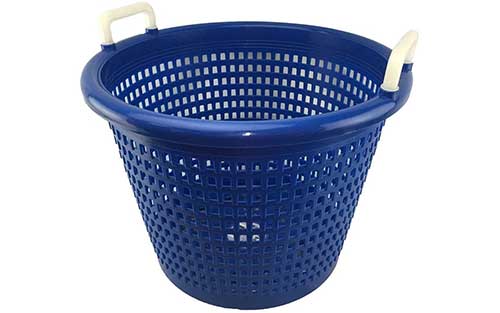
Buy from Amazon
This Lee Fisher Joy heavy-duty fish basket can be used for multiple purposes. In this case, it works perfectly for storing large cast nets. Color options are blue or green and similar baskets come in orange. These baskets are commonly used to transport, shrimp, crabs, lobster, and fish that are caught by commercial fishermen.
These work great for cast net storage because the holes in the basket allow the cast net to dry. A large cast net should ideally be rinsed and hung up each day. This basket allows the cast net to be easily rinsed with fresh water. Ideally, the case net would not be stored in the sun so placing the basket in a shading area is a good idea.
Fish You Can Catch with Live Bait
Catching live bait is very important when fishing in the ocean. Common fish caught on live bait include.
Saltwater Fish
- Mahi-mahi
- Tuna
- King mackerel
- Striped bass
- Tarpon
Live bait is typically best, but in many cases, fresh-cut dead bait works very well. On some days lures work great to catch fish. However, the most consistent way to catch fish is by using live bait. Inshore fishing and reef fish both heavily rely on live bait. Common Saltwater Bait Fish used to catch these fish include, pilchards, mullet, bunker (Menhaden), goggle eyes, ballyhoo, threadfin herring, pinfish, and scaled sardines
Freshwater Fish
- Bass
- Catfish
- Crappie
- Hybrid striped bass
Freshwater fishermen often overlook using live bait. It is important to check the local regulations when using cast nets in freshwater. Sometimes creek chubs work really well to catch bass, especially in ponds. Also, hybrid striped bass are frequently caught at night using alewife which is a type of herring. Check out the different types of freshwater baitfish.
Cast Net Care and Maintenance
Taking care of the net will make it perform better and last longer:
- Store it in a cool dry location out of the sun
- Use a commercial fishing basket for storage – it’s open to the air and has holes in the bottom which allows water to drain
- Once a net is dry, it can be stored in a bucket for long-term storage
- Occasionally soak the net for a few hours in fabric softener to clean, wax, and loosen it
Many charter fishing companies rinse and hang the cast net each day to keep it in good condition. The cast net should definitely be put away clean, without holes, and untangled each day.
Cast Net Repair Techniques
It’s common for a cast net to have braille lines break, netting get torn, and have large fish punch holes through it. A new cast net is not needed each time this happens.
Repairing Holes
The easiest way to repair a hole or tear is by tying knots in the mesh with 10-30-pound test fishing line. I use a 30-pound test monofilament fishing line and tie a uni knot. A knot should be tied about every 1-inch along the hole or tear.
Fixing Braille Lines
If a braille line breaks, it’s important to fix it or the cast net will not close properly. Locate where the braille line broke and use a 60-80 pound test line to repair it. Often times a double uni knot is needed to add extra length back to the braille line.
Lead Line Repairs
It’s unusual for the lead line to break, but the mesh along the lead line is a common place for the net to tear. This can be repaired the same way as the mesh netting with a 10-30 pound fishing line used to tie knots every 1-inch.
Cast Net Mechanics: How They Work
A cast net is a circular mesh net with a 6-24-foot diameter. Along the perimeter of the net are lead or steel weights. The weights are connected to the lead line which is connected to 16-26 braille lines that are evenly spaced and tied along the lead line. A hand line is connected to the braille lines using a large swivel. Mesh netting is connected to the lead line on the bottom and horn at the top. The horn slides over the braille lines as the cast net closes.
The net is thrown by a single person and opens in a circle. As it sinks, it traps most types of baitfish. When the hand line is pulled up, the bottom of the net is closed because the braille lines pull the net together. This results in trapped bait that can be quickly emptied into a live well.
Captain Cody has worked on charter fishing boats in the Florida Keys, Virgin Islands, and Alaska. Growing up in Pennsylvania Cody has also done extensive freshwater fishing including bass fishing tournaments. Cody strives to provide detailed information about the best fishing gear and tactics to help both novice and experienced anglers have a more productive and enjoyable time on the water. Cody also has a background in aerospace engineering and neuroscience but really only takes pride in being good at one thing and that is fishing!
How To Throw a Cast Net
In this article, I will show you the two easiest ways to throw any size cast net. The first way works for any size cast net from 3-12 feet in radius. The second method is a fast way to throw small cast nets that have a 6 foot or smaller radius.
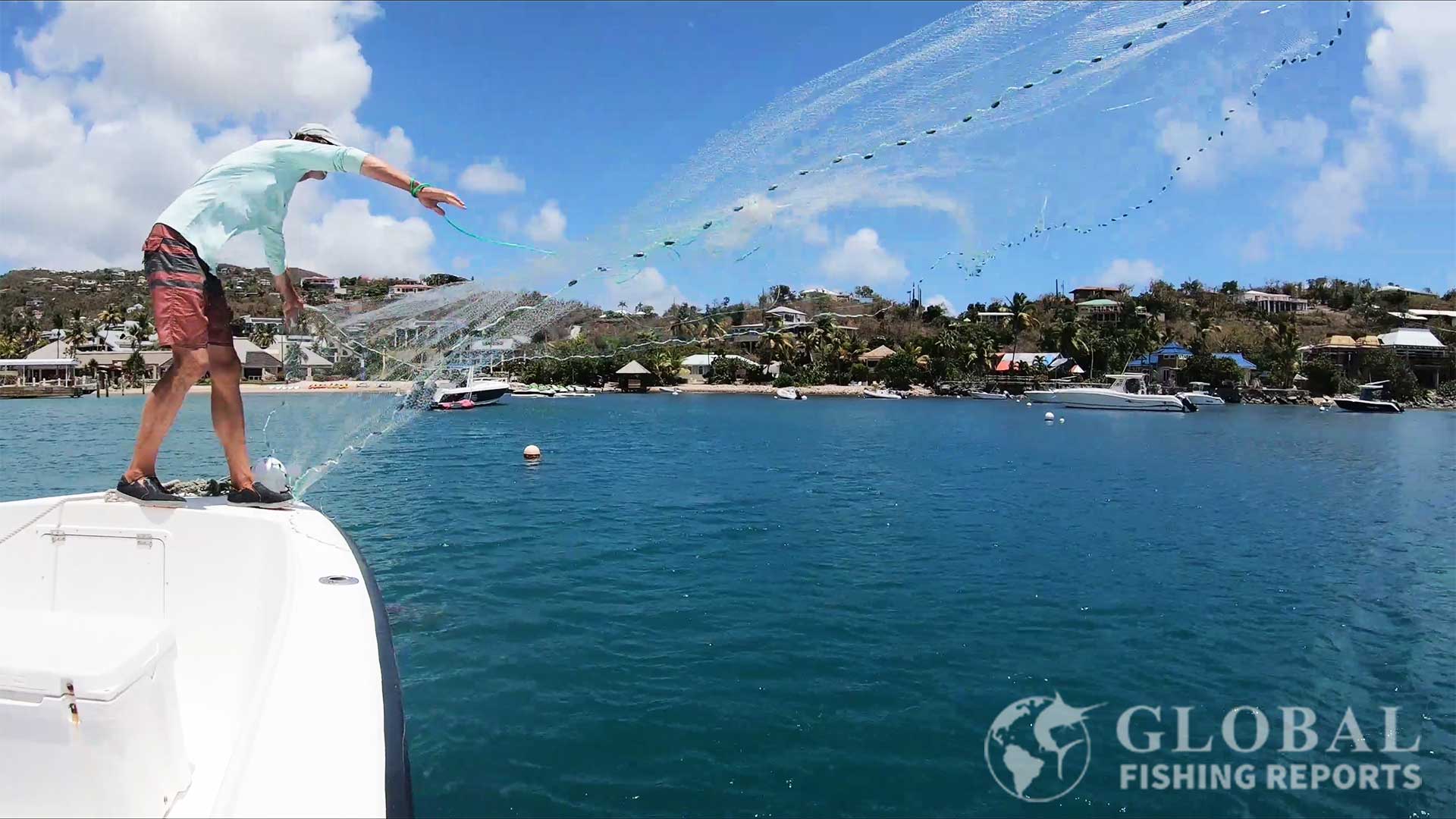
Throwing a cast net is one of the most useful ways to catch bait for fishing. It is also a fun activity for kids to do to catch fish and then let them go. Often times people get frustrated when the cast net does not open. With practice, throwing a cast net can be a fun activity. Cast nets range in size from 3-foot to 12-foot radius and are made by multiple companies. If you are looking to find the good cast check you the best cast net page.
How to Throw a Cast Net, Any Size, No Teeth, Stay Clean
1. Untangle the Cast Net

The most important step to throwing a cast net is to untangle the net. Some cast nets get more tangled than others. If the net gets caught in sticks and debris it will take more time to untangle. A quick and easy way to untangle the net is to pull 100 percent of the net from one side to another. If there are snags the net will not go from one side to another and will get caught. Typically just pulling had or lifting one side will work out the tangles.
The importance of untangling the net is often overlooked by people who throw cast nets. They assume the net does not open properly because of the technique. This could be the case but more often the net is just tangled and would not open properly for anyone who threw it. Sometimes the net does not even need to be untangled and other times it will take 2-10 minutes to properly untangle the net. If the net is old, torn, or beat up it is much more likely to tangle.
2. Coil the Cast Net Hand-Line
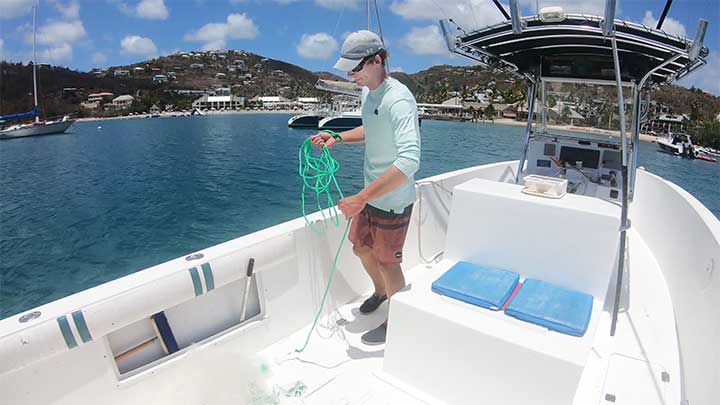
The hand-line should be coiled up just like wrapping up and extension cord. Make small wraps and place the rope in the right hand. If the rope is not properly secured it can get caught in the cast net resulting in the net not opening properly.
3. Straighten Out the Cast Net and Hold Under the Horn
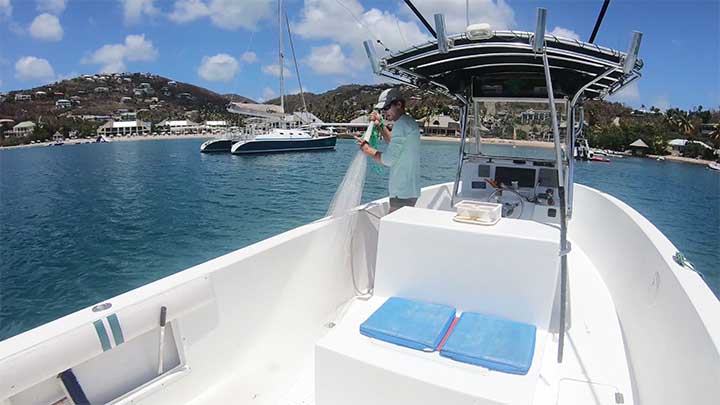
Next, the net is pulled into a straight line. The braille lines within the net are connected to the lead line and are what closes the net. These should be also be pulled completely straight. If these are staggered or twisted the cast net might not open or close properly. Grab the net close to the horn with the right hand.
4. Make Several Coils of the Net
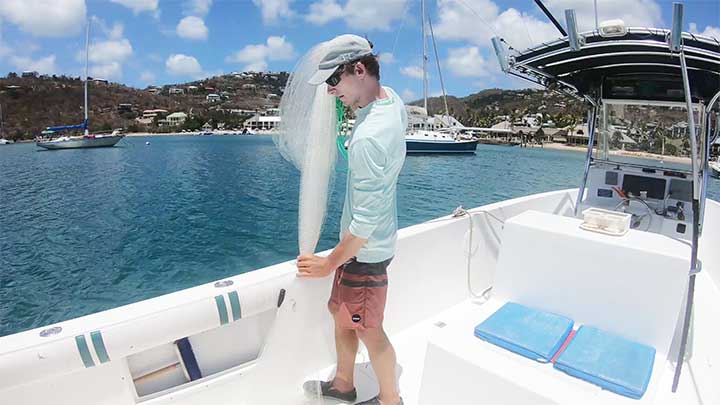
Wrap the cast net into several coils by collecting about one arm’s length of the net in each coil. Stop collecting when the net is about as tall as the person throwing the net. Grab the net at about the waist or hip level to make the final coil of the net. This makes the net a manageable size to pick up and throw.
5. Pull 1/3 of the Cast Net From the Front
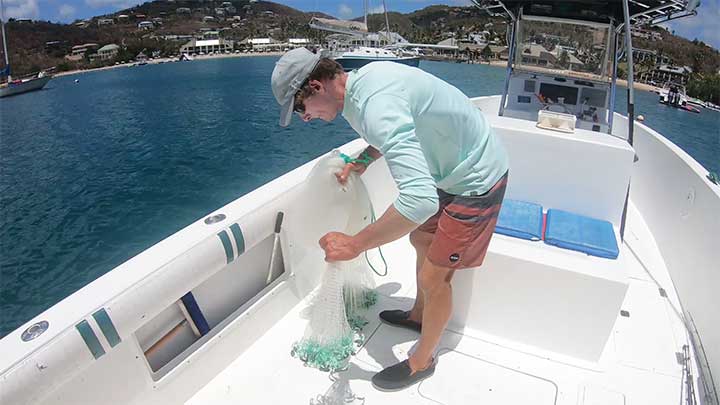
Starting from the left and pull out about 1/3 of the cast net. This is done by fanning the net and collecting it to ensure that there are not any tangles. Collecting the net this way is similar to how it was pulled from one side to another to untangle the net in step one.
6. Place the Collected Cast Net into the Right Hand
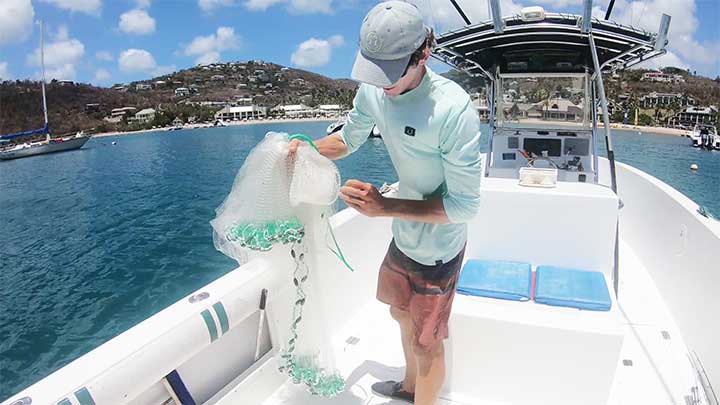
Next, take the collected net and place it in the right hand with the rest of the coiled net. At this point, there are two sections of the net a high section and a low section.
7. Take the Lead Line and Put it in the Right Hand
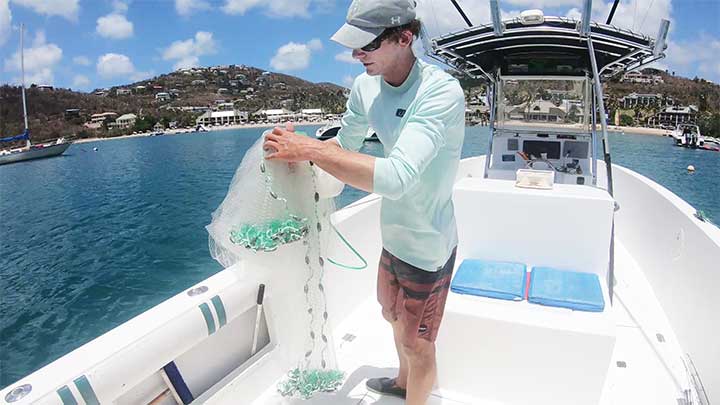
Grab the lead line the starting from the low section of the cast net. Place the line into the right hand. This helps to start opening the net right away.
8. Collect 10 Percent of the Remaining Lead Line

Next, pull about 10 percent of the net from the lower section of the net. This further separates the net and makes it easier to throw. If the net is under 6 feet this step will not really be needed. For large cast nets, this makes it more manageable to throw.
9. Swing the Net Back and Focus on the Bait
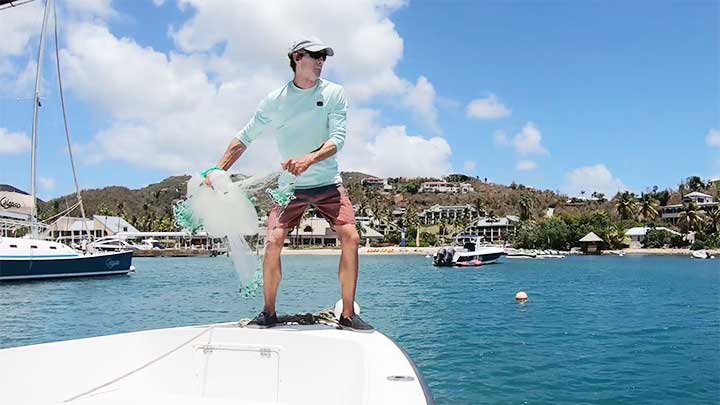
Swing the cast net back towards the rear. This loads the net and your muscles to act as a spring to allow the net to be thrown forward with lots of force. Watching the bait is very important just to ensure proper net placement. With large cast nets, it is going to open directly in front of you so make sure that is where the bait is located. If you throw to early or late it does not matter how good the opening is because no bait is there to be caught. Patience and good timing often work better than lots of casting.
10. Trow the Net Forward with the Right Hand
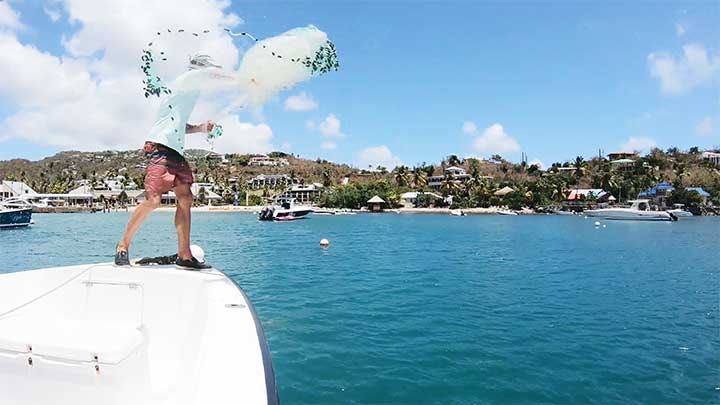
At first, it seems strange that just throwing the net forward will make such a large net open. How the cast net is wrapped allows the weights to spread out during the throw. If the net has any tangles it can become snagged and does not separate properly during the throw. Also, heavy side winds can cause a partial opening. In heavy winds, it best to throw with the wind. Sometimes the baitfish do not cooperate though.
11. As the Net Spreads Out Pull Back with the Left Hand
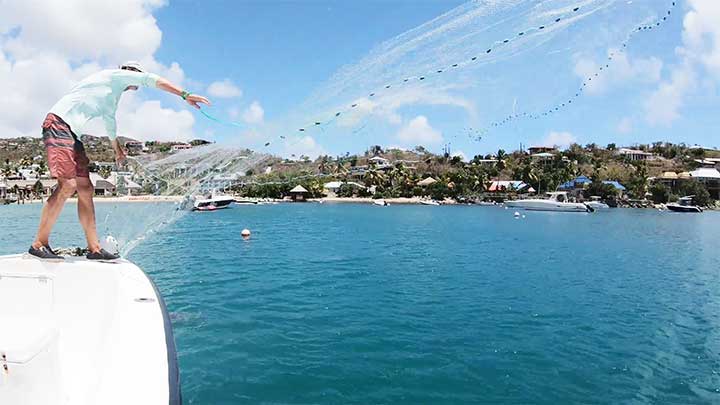
After throwing the forward with the right hand pull back with the left hand. This happens quickly and once you throw more and more it becomes a habit. Hold onto the net with the left hand a pull it across your body. As the net drops, it pulls on the left hand a bit harder and that is a good time to release. This action allows the weights to separate and open the net.
12. Let the Cast Net Sink to the Bottom
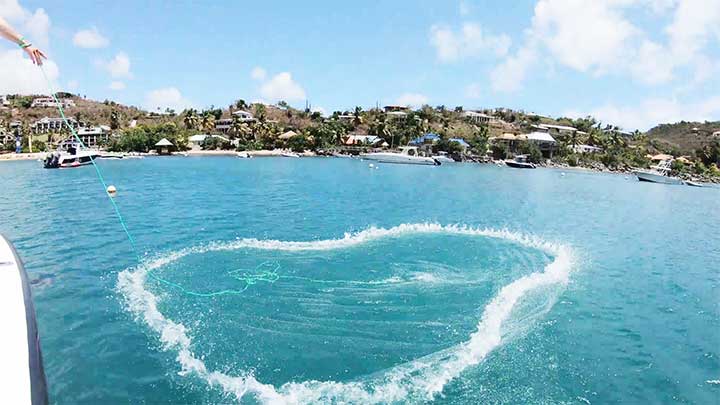
Once the cast net is in the water the lead weights allow it to sink. Depending on the amount of weight and size of mesh determine how fast the cast net sinks. Smaller mesh size will cause the net to sink slower because of the extra drag. In most cases you want the net to sink all the way to the bottom. If the bait is near the surface and the bottom structure is not known the net can be closed before it hits the bottom. Do not just pull the net up quickly though because it will lift while closing and the bait can escape out the bottom. Make short tugs and let the net sink again so the bait can not escape. Once you think the net has closed it can then be quickly retrieved.
13. Make Short Tugs on the Hand-Line
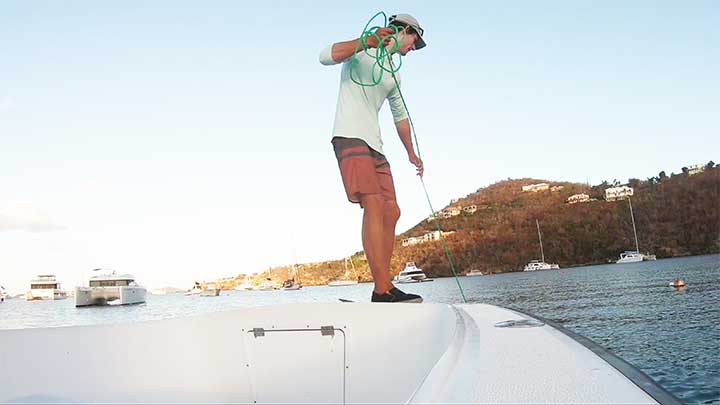
Once the net stops sinking the slack in the line should be collected. Make short little tugs while slowly pulling the net up initially. This allows the net to close without actually lifting the net off the bottom. The cast net will also catch any other items on the bottom as well like rocks, coral, sticks, and seaweed.
After throwing the net in the area you become familiar with the bottom structure. Some bottoms like sand and dirt allow the net to easily closed on the bottom. In other places, the net might get snagged and even tear while pulling it up. When throwing in a new place I am cautious at first and might even throw a smaller net that is less likely to get stuck on the bottom. If it is stuck you can always jump in and untangle it. From shore, this is easier than when on a boat.
14. Once the Net is Closed Pull Bait to the Surface
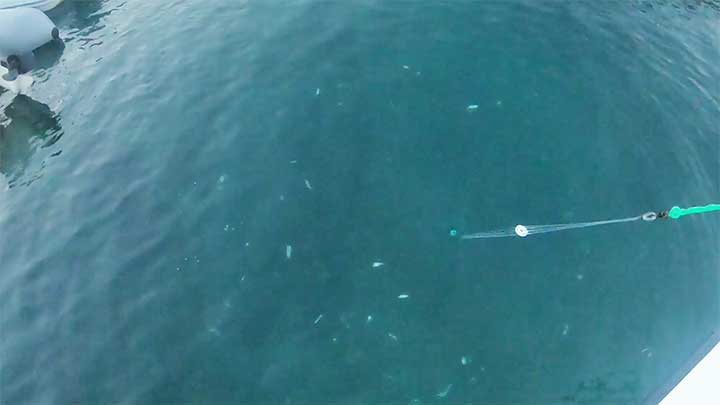
When you see flashes in the net when it is sinking there is a good chance you caught the bait. Often times you can even feel vibrations in the hand-line from fish hitting into the net. In the picture above the net is closed and you can see all the pilchards that are trapped in the net. This is what you want to see when you make a good throw. If there is not flashing then the chances are very little bait was caught.
Some days bait is difficult to catch and even a few baits will be kept from a bad cast. Other days, if lots of baits are not caught then the net will be emptied out into the water to save time. Ideally, all the bait for the day can be caught in one good throw. Usually, at first light the bait is most active near the surface where it can be easily spotted and caught.
15. Allow the Net to Drop Slightly Collecting the Bait in the Cast Net Pockets
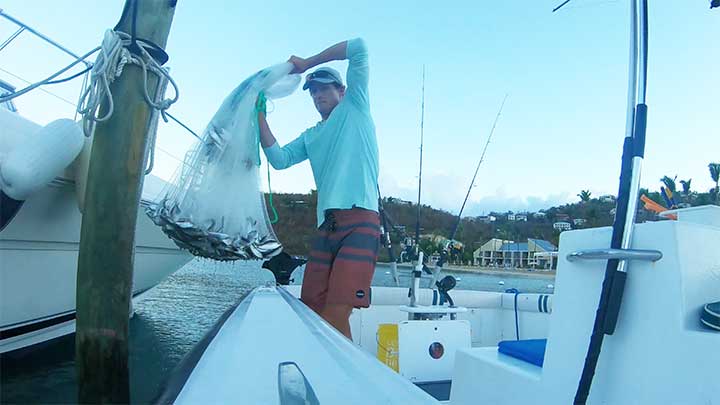
When a lot of bait gets caught it can actually be difficult to bring in and put into the livewell. When the lead line is almost out of the water you want to do what is called dropping the net. This is done by opening the grip on the net so it slides through your hands for a second. It feels like a bad idea at first like the net might open and the bait will escape. However, it just allows a pocket to form when the bait will collect. This makes the bait easier to transfer into the livewell.
16. Empty the Bait into a Livewell

To empty then net open the grip on the net allowing the braille lines to slide down. This opens the bottom of the net so the bait will fall into the livewell. Lift the net high and make sure to shake out any bait that might be stuck. When the bait storage location is elevated it can be difficult to empty the net directly into the tank. If this is the case, having a large bucket or basket to empty the bait into is nice. The bait can then be easily transferred to the livewell.
For more information about particular types of cast nets, check out the best cast net page.
17. How to Throw a Cast Net Video Demonstration
The video above shows how to throw a cast net. It is the same method described above. It takes some practice to get good at throwing a net. With time users become faster and untangling, loading, and throwing the cast net.
It is best to start with a cast net under 8 feet in diameter to become proficient at the basics of throwing a net. The main problem I have seen people have when learning to throw a net is letting the net get tangled. With a bad throw, the net is more likely to get tangled so the whole process becomes more difficult. Also, make sure you are holding the net in the right hand. Some cast net throwing methods have the user swing the net from the left hand. As a right-handed person, I feel it is much more natural and easier to throw with the right hand.
How to Throw a Small Cast Net
1. Hold the Net Near the Cast Net Horn
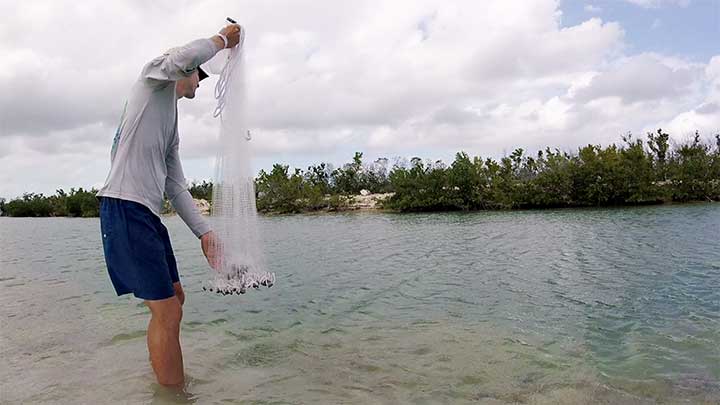
Hold the cast net near the horn with the right hand. If the cast net is shorter than you it can be grabbed right at the horn. If not grab a foot or two below the horn.
2. Grab the Lead Line Near the Base of the Cast Net
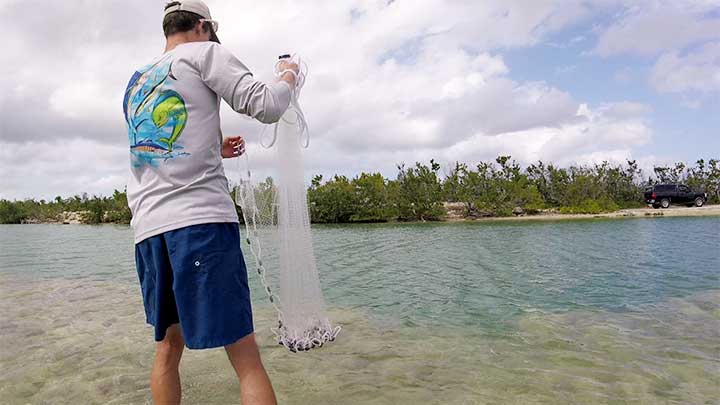
Reach down and grab the lead line that is closest to you with the left hand. In the right hand hold the coiled rope and the top of the cast net.
3. Place the Lead Line Over Top of the Net
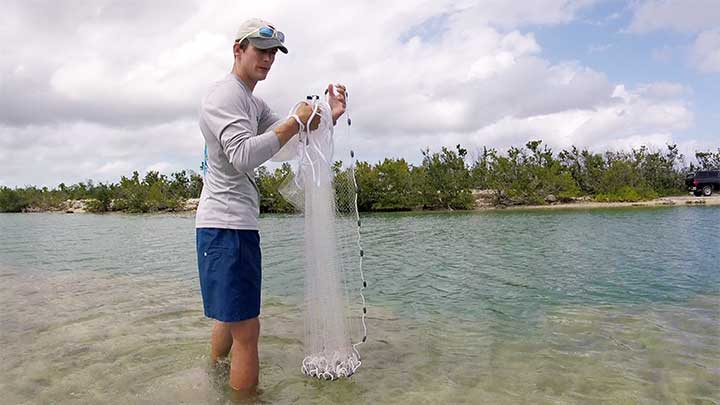
Next, the lead line is going to be placed over the horn of the cast net.
4. The Lead Line Goes Over Top of the Horn
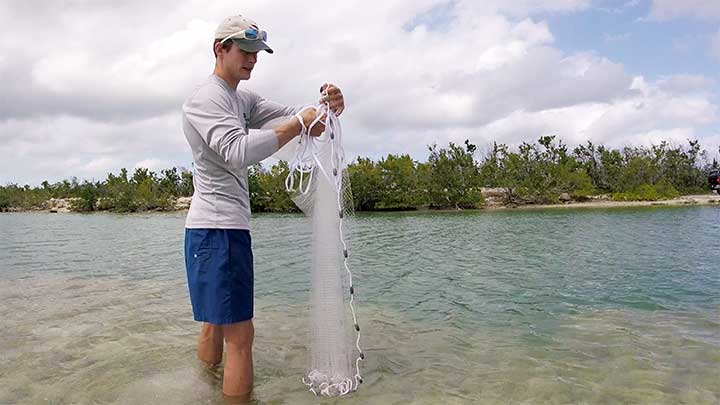
Place the lead line around the horn and then pinch it with the thumb. There is an easy throw cast net that has a large ring for the lead line to be placed in. This is using the same method. However, there is not a metal ring. Without the ring, it is actually easier to throw.
5. Hold Several Feet Down with the Left Hand
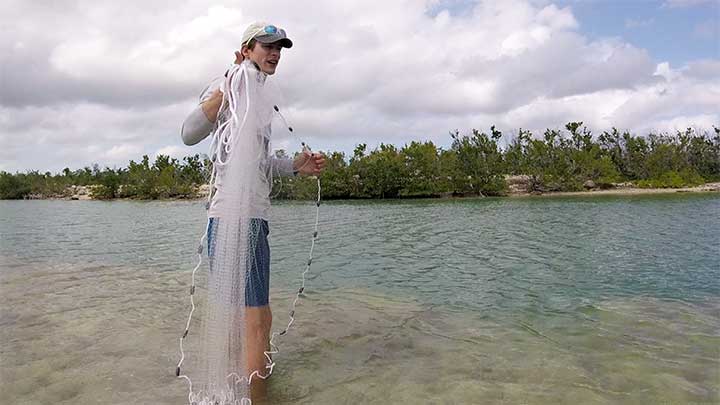
With the left-hand reach hold the net about two feet away from the horn.
6. Swing Back and Focus on the Bait
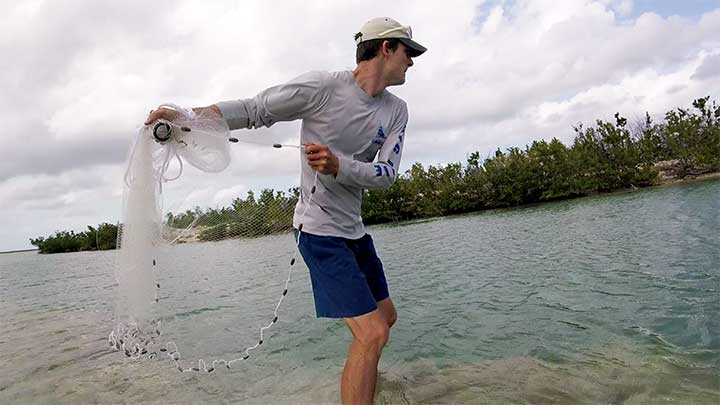
Swing the net back and look for where the bait is located. This is a small net and should be cast just in front of the bait in the direction that they are swimming.
7. Throw Forward with the Right Hand and Pull Back with the Left Hand
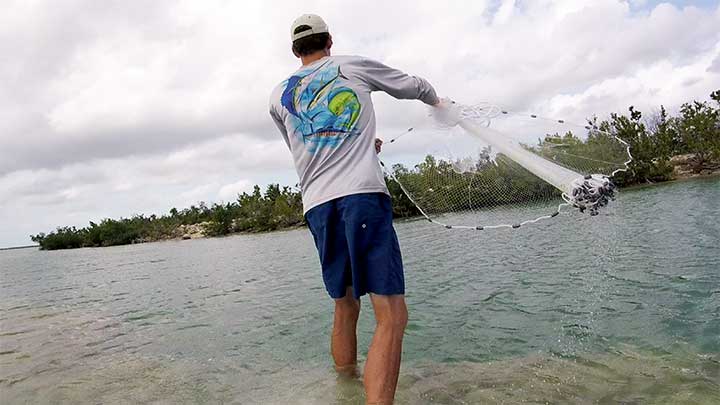
Bring the right arm forward and throw the net hard. Pull the left hand back and across the body. Let go of the net with the left hand last, slightly after the main net has been released.
8. Retrieve the Cast Net and Collect the Bait
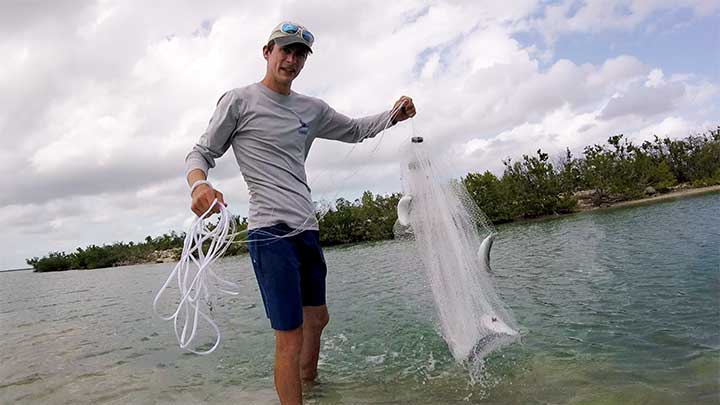
When the cast net hit the water let it sink. Then make short tugs to close the cast net. Pull the net the rest of the way in and see what is caught. Grab the horn and let the net slide down the braille line to open the net and release the bait. The mullet video below shows several demonstrations on how to trow a small net using this cast net throwing method.
The cast net page has more info about cast net types and sizes. The size of the net, mesh size and weight per foot are all important items to consider when selecting a cast net. The general rule of thumb is that for big baits a large net with a wider mesh size is best. For small baits, a small mesh size is needed.
Fish that are commonly caught with live or fresh bait include hybrid striped bass, striped bass, mahi-mahi, sharks, tuna, and tarpon.
How To Catch Mullet with a Cast Net
Mullet are often thought of as one of the hardest baitfish to catch with a cast net. This is because there are often found in deep clear water. The cast net needs to be large and sink fast to catch mullet under these conditions. Buying a large radius net with a large 1 1-4 inch mesh makes it so mullet can be caught in deep clear water.
Another trick is to catch mullet in shallow water or when they are near the surface. If you watch the water closely you can often see mullet swirling near the surface. The net has to be thrown in front of the mullet. Often the mullet can see the net coming and swim fast out the net when it is thrown directly on top of their current position. However, by leading the bait they can be caught.
How To Catch Bunker with a Cast Net
Bunker is another baitfish that can be difficult to catch with a small net. A large fast sinking net is important with catching bunker. If peanut bunker are located near shore they can be caught like other small baitfish. However, in deep water, other strategies need to be used. It is common to see schools of bunker boiling near the surface. If the cast net is thrown on top of the bait the splash spooks the fast-moving bait and the fish can often avoid the net completely.
The trick is to slowly back of the bait school with the boat. This sends the bait deep. Once the bait is located on the fish finder the net can be thrown. In this case, the bait is not spooked by the splash. The large cast net will slowly sink over the bait in the murky or stained water. This results in a large number of the bunker being caught in one throw.
Frequently Asked Questions
How does a cast net work?
A cast net works by having a single person throwing a 4-12 foot radius net into the water. Lead weights around the perimeter of the net allow the net to sink in the water. Braille lines are connected to a hand-line and when pulled it closes the net. Bait can be caught in water ranging from 1 foot deep to over 20 feet deep. Game fish can not be kept if they are caught in a cast net. The intention of a cast net is to catch live baitfish.
How do you throw a cast net perfectly?
The are multiple ways to throw a cast net. The triple load method is a common way to throw a large cast net. However, with this method, the net needs to be placed on the body. After the first throw, the net is wet and it is not an enjoyable way to throw a net. The method described above is the easiest way to throw a large cast net. There is also the easy throw method described above that works great to throw small cast nets.
For a perfect cast net throw, the net should be loaded fast. The method should not require the net to be placed on the person and teeth should not be needed to hold the net. When throwing the net should open fully in a round circle. This is often called throwing a pancake. The net should be in a position to catch the most bait. Sometimes this is directly over the fish and sometimes the net should be placed in front of where the fish are moving. When the net sinks it should trap all the bait. The net should close without lifting so that bait does not escape out the bottom. The bait should be quickly transferred into a livewell.
What size cast net is best?
There are two sizes that are important when selecting a cast net. First is the radius of the cast net. Which size cast net is best depends on the user’s abilities, and the type of fish being targeted. A 3-foot radius net is the smallest cast net. That size is made for kids. For adults, a 4-foot radius would be the smallest net you would likely want. A 12-foot net is good charter captains that want to quickly catch lots of bait for the entire day. Most people are best off getting a net that has between a 5-10 feet radius.
Next is the mesh size which ranges from 1/4 inch mesh to 1-1/4 inch square mesh. Most mesh sizes given are in terms of square mesh. For example, a 3/8-inch square mesh is 3/4 inches when stretched. Another example is 1-1/4 square mesh is 2-1/2 inch when stretched. The most common mesh size for cast nets is 3/8 inch square mesh. This works well for catching baits that are 2-6 inches in length. The cast net page has a list of the many types and sizes of cast nets.
What are the methods to throw a cast net?
The best methods to throw a cast net are the triple load method, the Percy method, and the method described above. These all work great for throwing large nets with a radius over 7 feet. For smaller nets, under 6 feet the easy throw method also described above can be used.
How much does a cast net weigh?
An average cast net weighs 1 pound per radius foot. That means that a 6-foot cast net would have 6 pounds of lead or steel weights. The netting material and hand-line weight are not included in that weight but these only make up about 10 percent of the total weight of the cast net.
The heavier the cast net the faster it will sink for the given mesh size. Most steel weight cast nets have about .75 pounds of weight per radius foot. Some custom nets have 1.5 pounds of lead per radius foot. Personally, I like nets that have 1-1.3 pounds of lead per radius foot when throwing in deep water. In shallow water, less than 2 feet deep the weight of the net is not as important. Sometimes a lighter net is nice since it can be thrown far and results in less fatigue when throwing it over and over to try and catch bait.
Captain Cody has worked on charter fishing boats in the Florida Keys, Virgin Islands, and Alaska. Growing up in Pennsylvania Cody has also done extensive freshwater fishing including bass fishing tournaments. Cody strives to provide detailed information about the best fishing gear and tactics to help both novice and experienced anglers have a more productive and enjoyable time on the water. Cody also has a background in aerospace engineering and neuroscience but really only takes pride in being good at one thing and that is fishing!
17 Types of Saltwater Baitfish
Baitfish are the food source of many predator fish. There are many different types of baitfish in freshwater and saltwater. Although it takes a little more effort to catch and fish with live bait it is one of the most productive and consistent ways to catch fish. In this article, the best saltwater baitfish will be discussed.
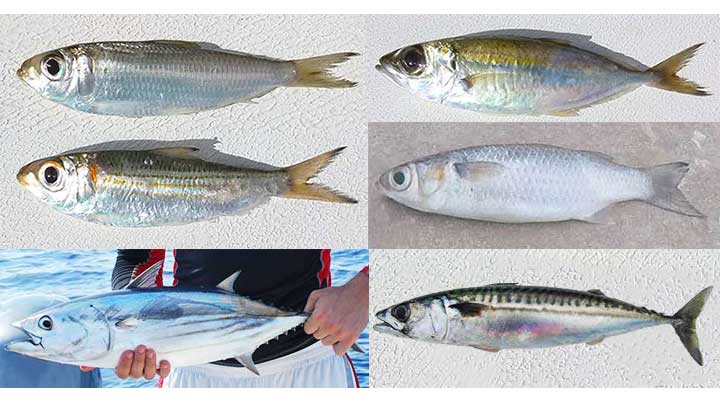
There are several ways to catch baitfish including using a cast net, minnow trap, seine net, sabiki rigs, and pinfish traps. The best type of baitfish depends on the fishing location and what the fish are naturally feeding on. Other baits including shrimp, squid will be included as types of baitfish since they are widely used as live or fresh bait.
The most common baitfish I use while fishing in saltwater includes pilchards, ballyhoo, mullet, and pinfish. It is important to have a good livewell to keep the fish alive. If you do not have a way to keep the bait alive fresh dead bait still works to catch many types of fish.
Types of Saltwater Baitfish
1. Pilchards
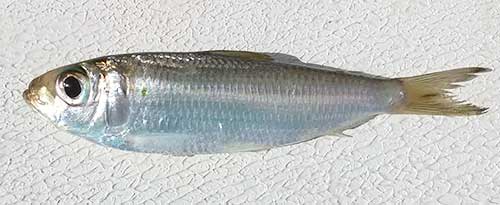
Pilchards are one of the most popular baits to use inshore, on the reef, and offshore. These baits are small enough to catch small snapper and enticing enough for large tuna, mahi-mahi, kingfish, tarpon, and most other predator fish to bite. Since the bait is small they work best with a small live bait hook or small jig. The bait will not last well in a bait pen overnight so is typically caught fresh for live bait each day. Throwing some of these overboard is a good way to bring fish near the boat. Typically it is best if they are injured or dead so they do not swim away. Do not over chum though as this will make fish less interested in your fresh baits.
These baitfish are caught for bait using a cast net. They swim in large schools so it is common to catch 100 plus fish in one cast. Pilchards do not typically eat standard chum so using sabiki rids or pinfish traps does not work. A very similar fish called a greenback can be caught with a sabiki rig. Greenbacks or greenies are slightly larger when fully grown. It is best to catch the bait with a cast net early in the morning when these baits are flicking on the surface. Looking for diving birds is a good way to locate the bait.
2. Scaled Sardines, Threadfin Herring
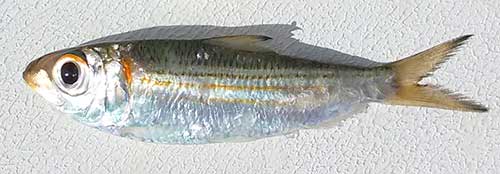
Scaled sardines are what we usually refer to as scalies. These baits are typically caught inner mixed with pilchards and threadfin herring when using a cast net. Scaled sardines are usually 3-5 inches in length and work well as live bait. These are called scalies as you will notice the scales come off easily, which is not ideal for live bait. Even though some scales come off the bait should stay alive in the Livewell for a full day of fishing.
3. Ballyhoo
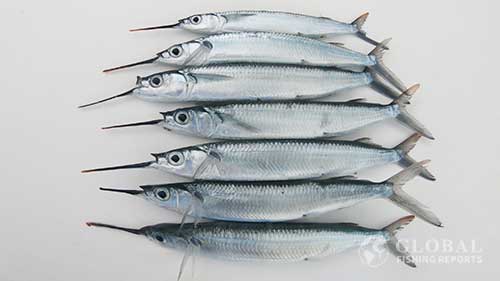
Ballyhoo is one of the most common baits to use when offshore fishing. In most cases, the bait is not alive but is trolled or pitched to catch mahi-mahi, tuna, sailfish, marlin, and wahoo. When trolling it is common to add a skirt to the bait to make it run straight more easily and also give it a bigger profile. It can be trolled without a skirt which is called naked ballyhoo. When pitching baits a full or chunked ballyhoo can be used to cast the bait near mahi-mahi.
Ballyhoo will show up in chum lines inshore and on the reef. This type of bait can be caught with a sabiki rig, small bait hook, cast net, or a specifically designed net called The BallyHoop. If you catch fresh ballyhoo while fishing it can be used as live bait. Fresh ballyhoo does stay better longer than frozen ballyhoo. It is common to salt the bellies of frozen ballyhoo to prevent the belly from washing out as quickly. Once the belly breaks apart the bait is more likely to spin and not run straight.
4. Mullet
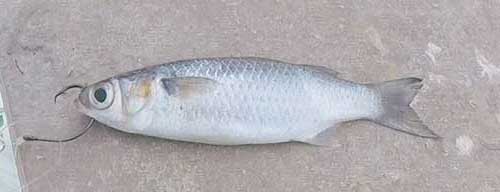
Mullet is a very good bait to use inshore. It is a very popular bait when fishing for tarpon. Other target species that mullet is good to use for bait include barracuda, sharks, redfish, and bluefish. When fishing for tarpon live mullet and fresh dead mullet both work well. It is common to cut off the tail and butterfly the fillets for the back of the fish when using dead mullet. A thin circle hook in the front lip is a good way to hook the fish. The bait should be suspended from a lightweight float in most cases when fishing inshore.
Mullet are typically caught with a cast net. In the shallows, mullet is easier to catch than in deep water. When cast netting in deepwater a large fast sinking net is needed. Finger millet 2-4 inches in length is better for small fish while large mullet can be good for catching large tarpon. Most people say mullet can not be caught using a rod and reel. However, mullet can actually be caught on a hook using small pieces of bread.
In the video above I am catching mullet with a 6-foot radius cast net. The mullet are caught in shallow water and in deep water when the fish are near the surface. Cast net placement is very important as mullet swim very fast a can evade nets that are not thrown correctly.
5. Bunker Menhaden
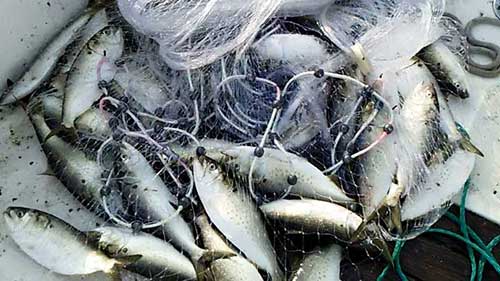
Menhaden is more commonly called bunker. This is baitfish found in large schools along the east coast of the United States. Most people use bunker to fish for striped bass and bluefish. It is also a good bait for weakfish, sharks, tuna, and small peanut bunker can be used for sea bass and fluke. Humpback whales and dolphins also feed on bunker so be on the lookout for these animals when fishing as well.
Bunker feed of plankton and the two ways they are caught are with a cast net or a snagging rig. If you just need a few fresh baits a snagging rig is an effective way to catch them. Find a school, cast the line, and pull back on the fishing rod like you are aggressively vertical jigging. Once a bunker is snagged it can sink and be used as bait right there. It can also be reeled in and placed on a circle hook. If lots of bunker is needed for a long fishing trip using a cast net is the way to catch them.
In the video above I am catching bunker with a 10-foot radius cast net. The method is to back over the school with the boat and then throw the net when the fish are marked on the fish finder. This is a good way to catch lots of large adult bunker in just one throw. Juvenile or peanut bunker are caught in inshore waters, inlets, and harbors.
6. Goggle Eyes
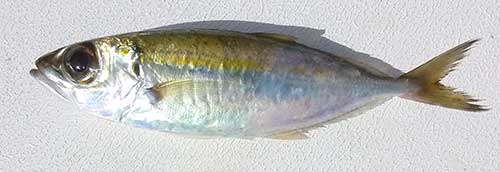
Goggle eyes are one of the most expensive and effective baitfish. This bait sells for between $3 and $10 a fish. It is in high demand during sailfish tournaments and winter sailfish season in Florida. These are also great batis to use for fishing for mahi-mahi, large tuna, and wahoo. The bait can be bridled onto the hook to last a long time. If pitching directly to a fish goggle eyes are hooked in the upper or lower back of the fish where the bait will not be able to swim away as quickly.
Fishing for goggle eyes is typically done at night with a baited sabiki rig or small bait hooks. This fish has large eyes and feeds at night. Goggle Eyes can also be caught during the day with a cast net but are hard to catch consistently. These fish can be kept in a large bait pen and use for the next few days. Don’t put them with too many other fish though or they will die quickly.
7. Herring
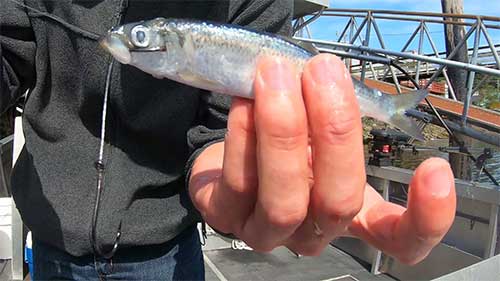
Herring is a very popular bait in both the North Atlantic and North Pacific oceans. In Alaska, Washington, Oregon, and California this is a good bait to catch salmon, halibut, and rockfish. When fishing for salmon herring is either trolled or mooched. The bait is hooked onto a rig with two snelled hooks. The herring is hooked in a way that makes it spin in the water. Typically when trolling a spinning bait will not catch fish but for salmon, this is the technique. Some anglers prefer to cut the head off and use plug cut herring. Properly hooking whole herring works just as well and is easier.
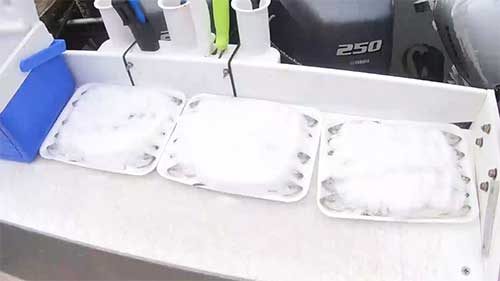
Herring come in flats with about 12 frozen herring in each package. It is common to salt the herring so that it is a tougher bait. This is smaller green label herring. Blue label herring is a bit bigger and then full-size herring can be purchased in large boxes. Full-size herring is good halibut bait but is a bit too large for salmon trolling.
Herring are typically caught by commercial fishermen using purse seiner boats. Cast nets can work but only Alaska residents can throw a cast net to catch bait. Sabiki rigs also work well to catch live herring. Live bait is rarely used in Alaska because all the target species will easily bite dead bait. Catching your own bait is a way to save some money and can be fun.
In the video above I show how to use herring for bait to mooch for salmon. This is also an effective way to catch rockfish and halibut. Herring are hooked up the same way when trolling for salmon.
8. Sardines
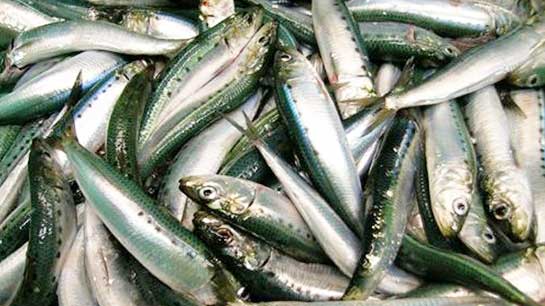
Image Source: Wikimedia Commons.
There are Spanish sardines in Florida but when most people say sardines they are referring to the pacific baitfish. This fish swims in very large schools and are prey for dorado, mahi-mahi, tuna, marlin, sharks, sea lions, whales, and dolphins. Sardines make good bait when fishing offshore or on the bottom.
Sardines are typically caught using large nets. Sabiki rigs can also be used to catch sardines. Many people think of canned sardines when hearing the word sardines as this is also a popular fish to each. Canned sardines do not make a good bait though cause they are mushy and do not stay on the hook well. They can be used as chum or mixed in with dough baits to add scent.
9. Sand Lance, Sand Eel, Needlefish

Sand lance are also called sand eels and needlefish. These fish are located in both the north pacific ocean and the North Atlantic ocean. In the pacific ocean large schools of sand lance conjugate on sand flats and gravel flats. I pulled the three sand lance shown above out of the stomach of a king salmon in Sitka Alaska. When there are not herring around sand lance makes up the majority of what is found in the stomach of early summer salmon. Sand lance are also food for halibut, rockfish, and cod.
In the Atlantic ocean, it is also common to find large schools of sand lance which are often called sand eels. This is a type of baitfish and not an actual eel. An eel also makes good bait for many types of fish. In the North Atlantic, it is common to use swim jigs that looks like sand eels when fishing. Diamond jigs are another good imitation. Sand eel imitations work well to catch striped bass, bluefish, weakfish, sea bass, and flounder.
It is not common for people to catch sand lance and use them for bait. Rather anglers troll or jig with lures that look like a sand lance. In the video above I show how to troll with downriggers. The two best baits to troll with are herring or sand lace imitations. Sand lance imitations are hoochies or flies. I like trolling sand lance imitations near the bottom but large schools of sand lance will swim at all water depths.
10. Cigar Minnow

Cigar minnows work as a very good bait on the reef and offshore. These are fished vary similar to goggle eyes when fishing for mahi-mahi, tuna, sailfish, and marlin. This is a hearty bait that keeps well in the livewell. It is also a large enough bait that it can be bridled onto a hook. Cigar minnows can be used on the reef to catch, barracuda, kingfish, cero mackerel, large snapper, grouper, jacks, and amberjacks.
There are two common ways to catch cigar minnows with a cast net or with sabiki rigs. When using a cast net chum is heavily used to get a large number of fish in one area. Chum balls mixed with sand are thrown in just before throwing the net. A commonplace to fish for cigar minnows is in grass flats in about 20 feet of water.
11. Silversides, Glass Minnows, Spearing

Image Source: Virginia Institute of Marine Science.
Silversides are also called glass minnows and spearing. This is a common baitfish along the entire Atlantic coast of the United States. I have seen them in large numbers in the flats in Florida, and off Cape Cod in Massachusetts. Also when fishing in New Jersey spearing are baits commonly given out on fishing charter boats when fishing for fluke. Silversides are small fish that should be used with small hooks. Using real spearing is good as the bait is scented which helps to get fish to bite. The issue is the bait can come off the hook easily. That is why scented artificial baits luke gulp has an advantage in some cases. Spearing is a good bait for fluke, flounder, striped bass, snapper bluefish, and sea bass.
These baits can not be caught on a hook. Using a cast net with small 3/16 inch mesh would be a good way to catch these for fresh bait. It is common to catch them off the beach. A seine net would also work in shallow water. A minnow trap may work to catch silversides but I have not tried to catch them this way. If you do not have fresh silversides a small swimbait, power minnow, gulp minnow, or thin spoon are all good imitation lures.
12. Mackerel

Mackerel baitfish are common to catch in the North Atlantic and South Pacific oceans. This is a fish that can be kept to eat or used for bait. There are many types of mackerel such as king mackerel, Spanish mackerel, cero mackerel, and wahoo are even in the mackerel family. For bait though anglers are talking about gree-back mackerel. Mackerel are a food source for tuna, marlin, sharks, sea lions, and birds.
The best way for sport fishermen to catch mackerel is with sabiki rigs. Cast nets could work if you know a good location to target them. Once caught mackerel can be bridled to use as live bait or cut into chunks. Mackerel will say alive in a large live well for a day of fishing. I have caught mackerel on sabiki rigs in Maine and Massachusetts.
13. Pinfish
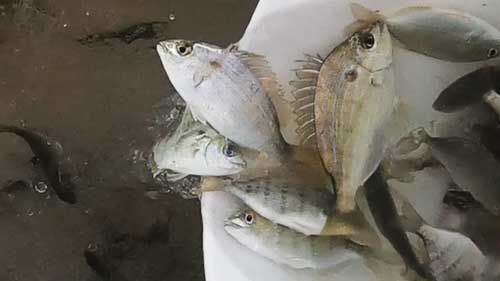
Pinfish reminds me a lot of bluegill or sunfish which are common freshwater baits. However, pinfish live in the ocean and are much more effective bait. Lots of predator fish will eat pinfish. Pilchards and mullet are typically my go-to baits when fishing in the ocean. Pinfish are the backup bait if it will be to time-consuming to catch the other bait. I like using smaller pinfish the best and they are actually a really good live bait. Target species when fishing with pinfish include tarpon, sharks, mackerel, barracuda, large snapper, grouper, jacks, amberjacks, and even sailfish. The bait is usually fished near the bottom or suspended on a float near the surface.
The best way to catch pinfish is with a pinfish trap. This type of trap is set out with chum inside overnight. When the trap is checked in the morning it will be full of pinfish if it was placed in a good location. The best thing about pinfish is they are really hardy fish. They will keep in a bait pen for weeks as long as they are fed. Pinfish will eat almost anything and we usually feed them fish scraps.
14. Flying Fish
Flying fish are one of my favorite fish to see when on the ocean. Chances are the water is a deep blue and the sun is shining. Most of the flying fish seen are just being spooked by the boat and the fish fly out of the water cause the boat scares them. If you are on the water at night flying fish are also scared of spotlights and that can make them fly. Flying fish are difficult to catch and use for bait but flying fish imitation baits and lures are commonly used. Flying fish can be caught with a small hook and a small piece of fresh bait.
Flying fish are most well known for being prey for mahi-mahi and frigate birds. The frigate birds follow the mahi-mahi and wait for them to chase the flying fish into the air where they have a chance of catching the fish. frigatebirds can not land on or enter the water so the fish must be scooped up right at the surface or in the air. Anglers fishing for mahi-mahi look for frigate birds that are following mahi-mahi so they know where to fish. Tuna, marlin, wahoo, and sailfish will also eat flying fish. The video above shows mahi-mahi and frigatebirds chasing down and trying to catch flying fish.
15. Bonito or Small Tuna
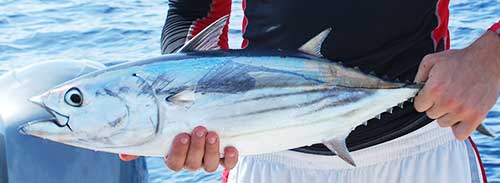
Bonito are typically caught while trolling small skirt baits. If you see tuna birds working near the surface chances are there are tuna or bonito around. A bonito has dark-read bloody meat that is not very good to eat but makes great bait. Small bonito have lighter meat and is actually a popular fish to eat. Small yellowfin tuna, skipjack tuna, and bonito can be used for bait to catch wahoo, king mackerel, large tuna, sharks, and marlin.
If you catch a bonito it is good to save for bait for several reasons. The fish can be filleted and used to make bonito strips for trolling. It can also be cut up and used for chunk bait. Chunks of bonito meat work great to catch mahi-mahi, snapper, barracuda, tarpon, and sharks. It can also be placed in a pinfish trap or feed to pinfish.
In the video above I show how to catch bonito and tuna while trolling. Baits used include Billy Baits Mini Turbo Slammer and C and H little stubbies. This was filmed in the Florida Keys but this technique should work to catch small tuna species everywhere.
16. Shrimp
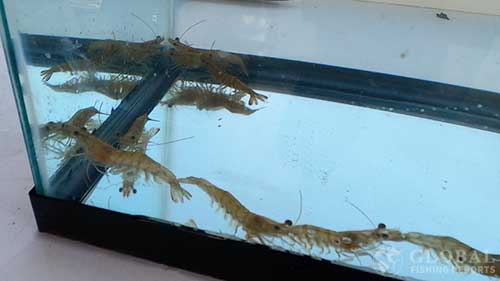
If you fish in the ocean you probably know that live shrimp is one of the most consistent ways to catch many types of fish. A live shrimp can catch a 3-ounce snapper or a 100-pound tarpon. I use shrimp most often on the reef. Depending on the current will depend on how much weight should be used, typically between zero and 0.25 ounces is best. This will catch all types of fish including yellowtail snapper, mangrove snapper, grouper, jacks, grunts, houndfish, redfish, ladyfish, pompano, permit, bluefish, and tarpon.
Shrimp can be caught using a cast net if you know where shrimp are located. It is more common to let shrimp boats catch them and then buy live shrimp from the bait store. Dead shrimp works well as long as it is super fresh. Old smelly shrimp is going to catch fewer fish in most cases. Unless you are targeting saltwater catfish which love dead smelly shrimp. Shrimp will also work offshore to catch mahi-mahi tripletail.
17. Squid
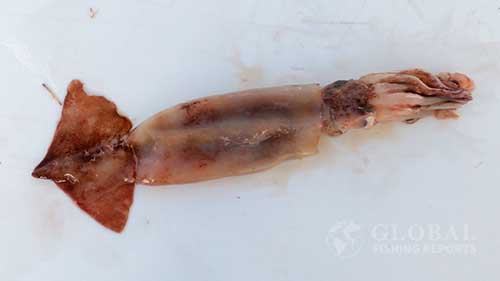
Squid is another one of the best baits for fishing. Most squid is bought frozen and used whole or cut up into small pieces. If you do not know what bait to use chances are squid will work. Personally, I really like to use squid to fish for croakers, mahi-mahi, tripletail, and halibut. It is also good bait to catch swordfish, tuna, billfish, snapper, fluke, flounder, grouper, tilefish, sharks, and most other ocean fish species.
If you mark a school of squid there are hook snaggers that can be used to catch them. I do not know many people that actually catch their own squid for bait though. Sometimes when snorkeling or scuba diving I will see some squid on the reef. Not the large schools which are usually in deep water during the day. There are many imitation squid baits that work great when trolling offshore.
Captain Cody has worked on charter fishing boats in the Florida Keys, Virgin Islands, and Alaska. Growing up in Pennsylvania Cody has also done extensive freshwater fishing including bass fishing tournaments. Cody strives to provide detailed information about the best fishing gear and tactics to help both novice and experienced anglers have a more productive and enjoyable time on the water. Cody also has a background in aerospace engineering and neuroscience but really only takes pride in being good at one thing and that is fishing!




 I am throwing a 12-foot cast net in the USVI.
I am throwing a 12-foot cast net in the USVI.































































What are your thoughts on a good deep hole shrimp net?
I am not positive on shrimp cast nets. It probably depends on the size of the shrimp but I think most people use mesh size smaller than 3/8 so 1/4 or 3/16. The bigger nets with more lead will likely catch more shrimp. Just make sure you are throwing it somewhere it will not get snagged if you are sinking all the way to the bottom. Lots of people do catch shrimp with cast net though.
Great rundown and nice detail. There are so many choices out there and it takes a while to figure out all the options. I burn thru 2-3 cheap nets a year due to the terrain, meaning heavy thick brush on theach bottom, but it is nice to throw a high quality net once in a while. There is a big difference but you get what you pay for.
Hello I like ur 3/8 mesh but am looking for a 12 foot with 1/8 mesh casting net hope u can help me find one thanks .
The Ahi USA 600 Pro Series 1/4 inch mesh is about the smallest I know off. Thier are 3/16 ich mesh nets out their but I have not heard of 1/8 inch mesh. That is very small.
Excellent tips! I am getting back into fishing after a long absence. I appreciate the easy to understand format you put this all into.